

The Beatles 1965 – A Detailed Guide
1965 was a seminal year for the Beatles, taking the band from the Beatlemania period through to the second half of the decade, where the group delivered their most critically acclaimed music. Several key events happened this year, from the last ever UK tour through to the moment Lennon and McCartney began to lose control over their own song rights.
It was a year that brought us a legendary concert from Shea Stadium, the increasing influence of drugs on their creative process as well as the band receiving their MBEs, but it all began with a Christmas show.
A Jolly Old Christmas Party
The year started with the continuation of the show that the Beatles were putting on at London’s Hammersmith Odeon, which had started on 24th December the previous year, called ‘Another Beatles Christmas Show’.
The show was a combination of sketches and music, with the Beatles normally appearing a couple of times in the middle of the show on sketches, traditionally with Freddy Garrity of Freddie and the Dreamers. They then returned at the end of the show to perform an 11-track set.
The show was put on for 14 of the first 16 days on the year, with two performances each night. The acts playing across the shows were – Freddie And The Dreamers, Sounds Incorporated, Elkie Brooks, The Yardbirds, Michael Haslam, The Mike Cotton Sound and Ray Fell.
Listen to a Beatles Christmas message from December 1964….
Touring Europe
1965 was an important year of touring for the Beatles, with multiple tours all concentrated on the second half of the year, but they were significantly smaller in scale compared to the massive tours that the Beatles went on during 1963 and 1964.
In fact, over the previous 4 years, the Beatles had barely gone through a month without performing live but after the completion of the Christmas shows in London, the Beatles only performed live once over a 5-month period. The band had become tired with all the constant touring and ultimately, we were only a year away from the Beatles ending all tours.
The Beatles first significant tour of 1965 began on 20th June, when they began a European tour that would run through to the 3rd July, covering 15 concerts across nine individual dates. Because of the decision not to tour again after August 1966 , this tour was the final European tour that the Beatles would ever complete.
The tour began in Paris, where they played to 6,000 fans at the Palais des Sports. They stayed in France for the next date, performing in Lyon a couple of days later, before moving on to the Italian part of the tour. This was the first and only time they toured Italy, performing 8 concerts in three different venues, ending with two straight days in Rome’s Teatro Adriano.
See our post “List of the Best Early Beatles Songs”
One trend from the Italian part of the tour is that the day concert (the Beatles performed a day show and an evening show) was never a sell-out. This is partly explained by the Beatles management because the fan base was likely at school or work, although the hot weather was also listed as a potential reason.
The Beatles headed back to France for a final concert in Nice, before going to Spain for their final couple of days of the tour, in Madrid and then Barcelona, for what would be their final ever European tour date, performed inside a bull ring!
The Beatles maintained the same 12 track set throughout their European tour – ‘Twist And Shout’, ‘She’s A Woman’, ‘I’m A Loser’, ‘Can’t Buy Me Love’, ‘Baby’s In Black’, ‘I Wanna Be Your Man’, ‘A Hard Day’s Night’, ‘Everybody’s Trying To Be My Baby’, ‘Rock And Roll Music’, ‘I Feel Fine’, ‘Ticket To Ride’ and ‘Long Tall Sally’.
Bring on America
Six weeks after the European tour concluded, the Beatles started a two-week tour of America, that would take up the second half of August, including a stop in Canada. The tour itself began with a fourth appearance on the Ed Sullivan Show, which would end up being their final ever performance on the show.
The tour itself could not have begun with a more memorable first night, the famous concert at Shea Stadium, home to the New York Mets. At the time it was a world record for revenue generated and attendance, but its most significant influence on history is that it was the first major stadium gig played by a pop band.
Footage of the concert (which was made into a 50-minute documentary) is the example of Beatles concerts that people always use when they talk about Beatlemania , which was at its height by this point. There were 55,000 screaming fans surrounding the band, who played on a rickety stage on the infield of the baseball field.
The band was introduced by Ed Sullivan, famously mentioning they were honoured by the queen and loved in America. In attendance, you had such musical greats as the Rolling Stones and Marvin Gaye. It’s even described by Rolling Stone magazine as the most famous concert by a band in Rock n Roll history, potentially even infamous.
Infamous because it is often used to illustrate the point that by this stage in the live shows, the crowd was so loud and maniacal that you could barely hear the band, who didn’t really have to put the effort into their live performances in the way that had in 1963 and 1964.
It is also the footage of screaming, crying and even fainting fans that highlight the hysteria that surrounded the group by this point.
After completing the gig, the band flew to Toronto for the only Canadian gig of this tour, before coming back to the US for nine more dates and 13 shows, starting in Atlanta. The tour takes in some of the most famous venues in America, including Comiskey Park in Chicago, Maple Leaf Gardens in Toronto and Hollywood Bowl in Los Angeles, where they played back to back gigs.
Indeed, it is at the Hollywood Bowl that they put on the best performance of the whole tour after Brian Epstein arranged for this gig to be recorded so that it could be produced into a film. It is arguably one of the last great, live Beatles performances.
It was also during the short break they took in LA on the tour that the band experimented with LSD , Ringo for the first time, whilst for George and John it was a second experience. Paul declined and his first experience of LSD was either later in 1965 or 1966, depending on whose story is accurate.
The band have extensively talked about their experiences and the influence it had on their later musical work. The tour itself and the time they had in America were influences for many of the songs on the Rubber Soul album.
One interesting side note is that during this tour, the band were able to visit the home of their musical hero, Elvis Presley, at his home in Bel Air. Lennon talks about the meeting extensively in an interview he does with the NME upon his return from America. It was the first-ever meeting between potentially the two most influential artists in music history.
The Beatles themselves were in awe of Elvis and had wanted to meet him for years. The meeting was arranged by Elvis’ manager Colonel Tom Parker, whilst Tony Barrow and Brian Epstein accompanied the band on the visit. Tony talks about a moment when Elvis asked for guitars to be bought out and a small jam session occurred, including a Cilla Black record ‘You’re My World’.
Unfortunately, the rules for the meeting were no press or any photography or video of any kind, so the occasion, iconic as it would be in music history, is not recorded for anyone to see.
In this video, Priscilla Presley recalls the meeting between Elvis and The Beatles.
Welcome Home
The final big tour of the year was back home, as the Beatles embarked on a tour of the UK throughout the first half of December, covering England, Scotland and Wales, although it didn’t start well.
On the drive up to Glasgow, one of the guitars fell off the back of the car. It was George Harrison’s Gretsch guitar and when they finally found it, it was in pieces all over the motorway!
It was ultimately to be there final UK tour, because in 1966 their two tours were in the Far East and the US, before stopping all touring. When the tour finally started, things kicked off in Glasgow at the Odeon cinema, which they had played several times previously, including on the Roy Orbison tour in 1963.
After Glasgow, they moved south to Newcastle before Liverpool for their last ever gigs in their home city. They played the Empire Theatre, with a capacity of just 2,550, which they could have sold out multiple times as they had over 40,000 applications for tickets.

One can only imagine how many would have applied if they had known it was to be the Beatles last ever gig in Liverpool.
The band gradually moved south to London, stopping in Manchester, Sheffield and Birmingham on the way. Once reaching the capital, they played both the Hammersmith Odeon and Astoria Cinema in Finsbury Park, which George described as an incredible show. Previously the Beatles had found London gigs lacked the enthusiasm of Northern venues but the Astoria reminded him of peak Beatlemania.
The tour ended in Wales, the band doing two shows at the Capitol Theatre in Cardiff, a venue they had played in both 1963 and 1964.
The band generally stuck to the same 11 song set throughout the tour – I Feel Fine’, ‘She’s A Woman’, ‘If I Needed Someone’, ‘Act Naturally’, ‘Nowhere Man’, ‘Baby’s In Black’, ‘Help!’, ‘We Can Work It Out’, ‘Yesterday’, ‘Day Tripper’ and ‘I’m Down’.
Other Notable Live Performances
The Beatles appeared at the NME Poll-Winners All-Star concert for the third consecutive year, held at the Empire Pool in Wembley. They performed 5 songs at the event, including their latest single ‘Ticket to Ride’ of the yet to be released ‘Help!’ album.
The other live performance of 1965 was for a live TV show, performed at ABC Theatre in Blackpool for ABC TV. The show was called ‘Blackpool Night Out’ and was designed to promote the launch of the ‘Help!’.
It was the only television appearance for the band and was part of cutting back on doing promotional work, which was not well received by the press, but Brian Epstein was steadfast in his decision.
Other guests on the show were Pearl Carr and Teddy Johnson, Lionel Blair and Johnny Hart. Mike and Bernie Winters acted as comperes for the evening. The Beatles initially played 4 tracks – ‘I Feel Fine’, I’m Down’, ‘Ticket to Ride’ and ‘Act Naturally’ before Paul McCartney performed ‘Yesterday’ on his own, which was the first time that the track had been sung on UK TV.
As the group returned to close with ‘Help!’, John Lennon was heard uttering one of his classic one-liners, saying “Thank you Ringo, that was wonderful!”
In May of this year, the Beatles also made their 52nd and final appearance on BBC radio, recording seven songs for the BBC Light Programme, ‘The Beatles (Invite you to Take a Ticket to Ride)’.
In February of 1965, the Beatles began work on what would become their fifth album, ‘Help!’

The album’s recording process was a clear departure from how the Beatles had previously worked. Up until this album, the Beatles had essentially recorded all their albums ‘live’ in the studio, but on ‘Help!’ they choose to overdub a lot more, starting with the rhythm section, then overdubbing the vocals and finally any other instruments to produce the best final track.
Having completed the recording of the album at the end of February, the band flew off to the Bahamas to start working on a film of the same name, which they also filmed in Austria, Twickenham and Salisbury Plain. Filming went on, with the occasional break, until the summer, before its release at the end of July, with the premiere at London Pavilion Theatre.
The album itself followed a similar pattern to the previous soundtrack album ‘A Hard Day’s Night’, with the songs from the film on one side and other original and cover songs on the other side, which included ‘Yesterday’ , still rated as the most covered track of all time.
The album was released in August 1965 and reached number one in both the UK and US charts, with a nine-week run at the top of the UK charts.
The title track and ‘Ticket To Ride’ were the key singles from the album, both number one hits, whilst of course ‘Yesterday’ went on to become a big hit, it wasn’t originally seen as a candidate for release.

In many ways, ‘Help!’ is the bridge album, taking the Beatles from the Beatlemania era through to the more creative songs they produced in the second half of the decade. On the album, they included elements of country and western, folk, classical and rock.
Rubber Soul
After returning from their US tour, the band began recording their sixth studio album, Rubber Soul. The album itself had a better critical reception than their previous ‘Help!’ album and was heavily influenced by their US tour.
It was clearly the most mature album the band had produced so far and arguably showed Lennon at his songwriting peak with tracks like ‘Girl’, ‘Norwegian Wood (This Bird Has Flown)’ and ‘In My Life’.
It was also George Harrison’s most involvement in an album so far, contributing not just two songs but having a heavy influence on some of the arrangements and introducing the sitar for the first time, as he was becoming increasingly influenced by Indian music and culture in general.
The album was released in the UK and US in December, going to number one in the US in January 1966 and staying there for six weeks. Meanwhile, in the UK the album reached the top spot on Christmas day, knocking off their own album, ‘Help!’, from the number one position.
In many ways, Rubber Soul changed the way pop music was considered. After its release, the focus became about producing a quality album and not about delivering individual hit singles. It is many Beatles fans favourite album and was rated by Rolling Stone magazine as the 5th greatest album of all time.
Beatles for Sales EP
Beatles for Sale EP was a four-track EP released in April on 1965 and was the eighth EP released by the band, containing tracks from the LP of the same name. Overall, it spent 6 weeks at the top of the EP charts, with three of the tracks being Lennon-McCartney originals and one from Chuck Berry, his classic ‘Rock and Roll Music’ song.
Their Personal Lives
It was a good year for Ringo Starr, who proposed to Maureen Cox in January of 1965, before marrying her on 11th February at Caxton Hall in Westminster. Ringo proposed in the Ad Lib club, which was the nightclub of choice for the band at the time, where they had their own private table.
Not all members of the band were able to attend the wedding, as Paul was holidaying in Portugal at the time. John and George were in attendance and Brian Epstein was Ringo’s best man.
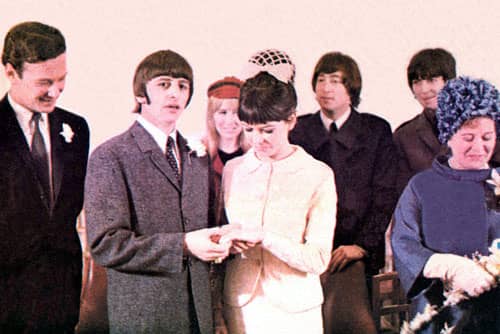
Although a long honeymoon was out of the question with the Beatles commitments at the time, the couple did manage a short honeymoon in Hove, Sussex, at the home of the Beatles solicitor David Jacobs.
In what was a busy year for Ringo personally, Maureen gave birth to their son, Zak Starkey, in Hammersmith. Ringo partly picked the name because he felt it was a strong name that couldn’t be shortened. Whilst never reaching even close to the fame of his father, Zak did follow in his footsteps to become a drummer, playing sessions with acts like The Who and Oasis.
Ringo Starr also purchased a first house with his new wife Maureen Starkey. Sunny Heights was a mock Tudor house in Weybridge. Less than one mile from John Lennon’s house, it was a large building with extensive gardens and even its own bar, The Flying Cow.
Paul McCartney bought a new house in St Jones Wood in April, which was just a short walk to EMI studios on Abbey Road where the Beatles did their recording at the time. It became a popular meeting place for the band outside of recording sessions.
Long after the rest of the band had passed driving tests, John Lennon finally got his drivers license in February of this year. John was renowned as a poor driver, not the greatest at concentrating on the roads.
He rarely drove after passing his test and unfortunately had a relatively serious crash with Yoko Ono, her daughter Kyoko and his son Julian in the car, with Yoko sustaining the worse injuries and also being pregnant at the time. After the crash, John was even more hesitant to drive and generally was found arriving at the recording studios thanks to his driver Les Anthony.
Losing Your Rights
One of the most significant events of 1965 wasn’t something that the Beatles and in particular John Lennon and Paul McCartney, considered to be as important at the time.
On 18th February, Northern Songs, the Beatles song publishing company, was floated on the stock exchange. The company had been owned between Paul, John, Brian Epstein and Dick James. As part of the process, just over a fifth of the companies’ shares were made available to the public, although the buying price would have put it out of the reach of most fans.
The reason behind the flotation was to ease the tax burden on Lennon and McCartney, who had achieved great success in the previous two years and were paying tax at 83 per cent. As part of the process, Lennon and McCartney were able to recoup a tax-free windfall of £94,270 each.
However, it is as a direct consequence of floating the business and making themselves vulnerable to takeovers, that the Beatles ultimately lost the rights to their own songs.
Having fallen out with the Beatles towards the end of the decade, Dick James sold his stake in the company to ATV, setting off a chain of events that would eventually see Paul McCartney’s former friend Michael Jackson own the rights to the Beatles back catalogue!
Having failed to counter the ATV offer to Dick James, Lennon and McCartney sold their own stakes in the company and as a result, lost control of the company.
Michael Jackson purchased the catalogue (along with a lot of other artists back catalogues), before eventually selling half his stake to Sony when he was struggling for money. Upon his death, Sony bought the remainder of the shares in the business and owned the whole back catalogue until Paul McCartney and Sony agreed an out of court settlement in 2017.
Members of the British Empire
On the 11th June 1965, it was announced that the Beatles were to be awarded the MBE (Member of the British Empire). Brian Epstein had asked Paul McCartney to come back early from his holiday with girlfriend Jane Asher to be around for the announcement.
The Beatles were nominated for the award by the prime minister at the time, Harold Wilson, who also happened to be the member of parliament for Huyton, Merseyside. The band went to Buckingham Palace on 26th October 1965 to receive their medals from Queen Elizabeth II.

However, back in the 60s, Rock n Roll was still not universally loved and still came associated with negativity by many in society. As a result, the Beatles being awarded the MBE kicked off a storm, especially with some previously decorated people, many of whom returned their medals in disgust.
Of course, the irony of these protests is that four years later, John Lennon returned his MBE to the queen. As he said in a letter to the Queen, he was returning the decoration as a protest to Britain’s involvement in the Nigeria-Biafra war, Britain’s support of the Vietnam war and as he jokes, the single ‘Cold Turkey’ slipping down the charts!
Their medals made one famous and public appearance after they received them. If you look very carefully at the album cover of Sgt Pepper’s Lonely Hearts Club Band, you will see their MBEs, except for John Lennon’s, who refused to wear his and instead is wearing medals loaned from Mona Best.
Lennon and McCartney received another set of awards in July of 1965 when they won five Ivor Novello songwriting awards.
After the fuss award the MBEs, John Lennon decided not to attend the awards and Paul himself was late and after accepting one of the awards, quipped that he hoped no one was going to send theirs back. Over their careers, Lennon and McCartney won 15 Ivor Novello’s.
Outside of the Music
John Lennon published his second book ‘A Spaniard in the Works’ in June, it was a 96-page book full of stories and illustrations by Lennon, selling 100,000 copies.

In another creative departure for the band, their first cartoon series appeared in the US this year, although the band themselves were not responsible for the voices in the series. What is interesting for later Beatles work is that the series producer, Al Brodax, would go on to produce and co-write Yellow Submarine for the band.
© Mathewstreet.co.uk
- The Beatles' 1965 UK tour
The Beatles ' 1965 tour of the United Kingdom was a concert tour that took place between 3 and 12 December 1965, comprising 18 shows [1] at nine venues across England, Scotland and Wales. [2] It coincided with the release of the Beatles' studio album Rubber Soul and their double A-side single " Day Tripper " / " We Can Work It Out ", and was the final UK tour undertaken by the band. [3] Weary of Beatlemania , the group conceded to do the tour but refused to also perform a season of Christmas concerts [4] [5] as they had done over the 1963–64 and 1964–65 Christmas seasons . [6]
Background and repertoire
Tour history.
Whereas the venues for the Beatles' summer 1965 tour of the United States had been arenas and large auditoriums, [7] their UK concerts were all held in theatres and cinemas. [4] The Beatles rehearsed thoroughly for the tour; according to George Harrison 's comments to the NME , their ensemble playing was also helped by their having just finished an intensive period of recording for Rubber Soul . [8] The album marked a significant progression from the band's Merseybeat roots, [9] furthering the musical direction they had first adopted with their late 1964 release, Beatles for Sale . [10] For the first time in their setlist for a tour, they now eschewed any songs from before the Beatles for Sale era. [11] The band chose their 1964 hit " I Feel Fine ", sung by John Lennon , to open the shows, while their closing song, Paul McCartney 's " I'm Down ", became what NME journalist Alan Smith later described as "the 1965 ' Twist And Shout '". [12]
Typically for the 1960s, the UK concerts were arranged in a package-tour format, with multiple acts on the bill [8] and two performances held each day. [4] The support acts on the program were the Moody Blues , the Paramounts , Beryl Marsden , Steve Aldo, the Koobas , and the Marionettes. [4] At £ 1000 per engagement, the Beatles' fee was the highest paid to a performing act in Britain up to that time. [4]
The group's preparation ended with a rehearsal on 1 December at the London flat shared by Neil Aspinall and Mal Evans [13] [14] – the Beatles' long-serving road managers and roadies. [15] Aside from the four band members and their manager, Brian Epstein , [16] the tour personnel comprised only Aspinall, Evans, press officer Tony Barrow and a chauffeur, Alf Bicknell. [17] On the way to Scotland for the first show, Harrison's Gretsch Country Gentleman fell from the group's car and into the path of a truck, [13] destroying the instrument and leaving him with two guitars for the tour. [18]
Wild, ear-tingling screams burst over the auditorium as the curtains parted and the Beatles moved straight into their first number, "I Feel Fine". John sang lead, and he was in top vocal – and humorous – form. From time to time he would throw in a funny facial expression that had the crowd roaring with delight. [12]
– Alan Smith of the NME , reporting on the opening performance of the tour
The opening shows took place at the Odeon Cinema in Glasgow on 2 December. [12] [16] In his feature article covering the first four stops on the itinerary – Glasgow, Newcastle , Liverpool and Manchester – Smith reported that while the fans' reaction did not seem as wild as it had been in previous years, "it's been capacity audiences, screaming [fans] and better-than-ever performances by the group all the way." Part of the reason for the less-frenzied mood surrounding the tour, Smith said, was due to a heavy police presence, which meant that roads around the venues were closed off and crowd numbers were confined to only those attending the concerts. [8]

The Beatles returned to their hometown of Liverpool on 5 December to play at the Empire Theatre , with their friends and family members among the audience. At the second show that evening, McCartney accompanied the Koobas (on drums) during their performance of " Dizzy Miss Lizzy ". [19] Otherwise, McCartney expressed disappointment at the level of police protection, saying: "just lately it's getting ridiculous. There are so many of them about, it ruins the whole atmosphere of enjoyment." [8]
The winter weather hindered the band's progress throughout the tour. [17] In Glasgow, Epstein was forced to change their accommodation to an inner-city hotel, to ensure that the Beatles made it on stage. [16] Travel was affected by snow on the roads around Newcastle, by dense fog in Manchester, and by heavy rain on the way to Birmingham . [19] At the first performance at that city's Odeon Cinema , the Moody Blues extended their set to cover for the Beatles' late arrival. [17]

The Beatles played the first of two London venues, the Hammersmith Odeon , on 10 December – the day the NME announced that its readers had voted them Best British Group and Best World Group for 1965. [20] In the same poll, Lennon won in the "British Vocal Personality" category. [21] The following day, Melody Maker listed Rubber Soul at number 1 on its national albums chart. [22]
Finsbury Park Astoria holds 3,000 people and I swear that almost every one of them has been standing on a seat … They tell me the hysteria and the fan scenes were even worse at Hammersmith last night. I did not think I would say this again but, without question, BEATLEMANIA IS BACK! [17]
– Alan Smith, NME
The 11 December concerts, at the Astoria in Finsbury Park , north London, received what author Barry Miles later described as a "tremendous" reception. [21] Retracting his earlier statement about the growing maturity of the group's fans, Smith wrote: "I have not seen hysteria like this at a Beatles show since the word Beatlemania erupted into headlines … George Harrison staggered off the stage soaking in perspiration as he told me: 'This is one of the most incredible shows we've done. Not just because of the audience, but because they're Londoners!'" Lennon elaborated: "We used to think Londoners had that cool we've-seen-it-all-before outlook but we take it all back!" [17]
The tour ended on 12 December with two performances at the Capitol Cinema in Cardiff . [23] Some 25,000 applications were received for the 5000 tickets. [24] These shows proved to be the final UK concerts the Beatles played outside London, [23] where they went on to perform for the last time at the NME Poll-Winners' Concert in May 1966. [25]
According to Walter Everett (lead singers appear in parentheses): [4]
- " I Feel Fine " ( John Lennon )
- " She's a Woman " ( Paul McCartney )
- " If I Needed Someone " ( George Harrison )
- " Act Naturally " ( Ringo Starr )
- " Nowhere Man " (Lennon, with McCartney and Harrison)
- " Baby's in Black " (Lennon and McCartney)
- " Help! " (Lennon)
- " We Can Work It Out " (McCartney)
- " Yesterday " (McCartney)
- " Day Tripper " (Lennon and McCartney)
- " I'm Down " (McCartney)
According to Barry Miles [26] and Walter Everett: [4]
- List of the Beatles' live performances
Related Research Articles
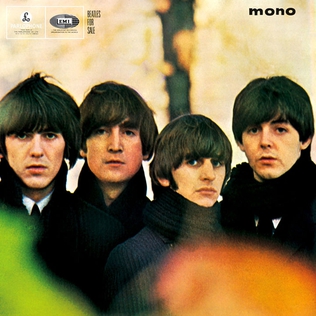
Beatles for Sale is the fourth studio album by the English rock band the Beatles. It was released on 4 December 1964 in the United Kingdom on EMI's Parlophone label. The album marked a departure from the upbeat tone that had characterised the Beatles' previous work, partly due to the band's exhaustion after a series of tours that had established them as a worldwide phenomenon in 1964. Beatles for Sale was not widely available in the US until 1987, when the Beatles' catalogue was standardised for release on CD. Instead, eight of the album's fourteen tracks appeared on Capitol Records' concurrent release, Beatles '65 , issued in North America only.
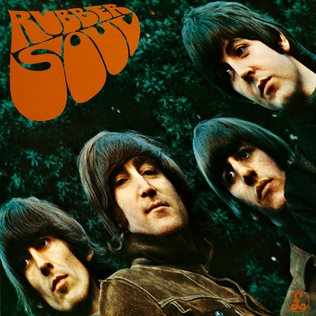
Rubber Soul is the sixth studio album by the English rock band the Beatles. It was released on 3 December 1965 in the United Kingdom on EMI's Parlophone label, accompanied by the non-album double A-side single "Day Tripper" / "We Can Work It Out". The original North American release, issued by Capitol Records, contains ten of the fourteen songs and two tracks withheld from the band's Help! album. Rubber Soul was described as an important artistic achievement by the band, meeting a highly favourable critical response and topping sales charts in Britain and the United States for several weeks.
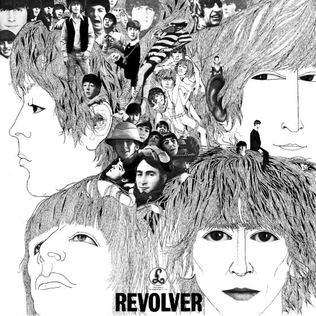
Revolver is the seventh studio album by the English rock band the Beatles. It was released on 5 August 1966, accompanied by the double A-side single "Eleanor Rigby" / "Yellow Submarine". The album was the Beatles' final recording project before their retirement as live performers and marked the group's most overt use of studio technology to date, building on the advances of their late 1965 release Rubber Soul . It has since become regarded as one of the greatest and most innovative albums in the history of popular music, with recognition centred on its range of musical styles, diverse sounds and lyrical content.
" Norwegian Wood (This Bird Has Flown) " otherwise known as simply " Norwegian Wood ", is a song by the English rock band the Beatles from their 1965 album Rubber Soul . It was written mainly by John Lennon, with lyrical contributions from Paul McCartney, and credited to the Lennon–McCartney songwriting partnership. Influenced by the introspective lyrics of Bob Dylan, the song is considered a milestone in the Beatles' development as songwriters. The track features a sitar part, played by lead guitarist George Harrison, that marked the second appearance of the Indian string instrument on a Western rock recording, four months after the release of the Kinks' "See My Friends". The song was a number 1 hit in Australia when released on a single there in 1966, coupled with "Nowhere Man".
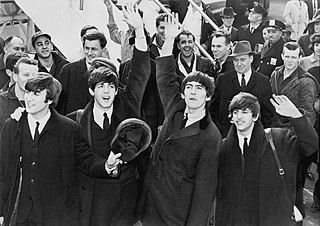
Beatlemania was the fanaticism surrounding the English rock band the Beatles in the 1960s. The group's popularity grew in the United Kingdom throughout 1963, propelled by the singles "Please Please Me", "From Me to You" and "She Loves You". By October, the press adopted the term "Beatlemania" to describe the scenes of adulation that attended the band's concert performances. From the start of 1964, their world tours were characterised by the same levels of hysteria and high-pitched screaming by female fans, both at concerts and during the group's travels. Commentators likened the intensity of this adulation to a religious fervour and to a female masturbation fantasy. Among the displays of deity-like worship, fans would approach the band in the belief that they possessed supernatural healing powers.

" Paperback Writer " is a song by the English rock band the Beatles. Written primarily by Paul McCartney and credited to the Lennon–McCartney partnership, the song was released as the A-side of their eleventh single in May 1966. It topped singles charts in the United Kingdom, the United States, Ireland, West Germany, Australia, New Zealand and Norway. On the US Billboard Hot 100 , the song was at number one for two non-consecutive weeks, being interrupted by Frank Sinatra's "Strangers in the Night".
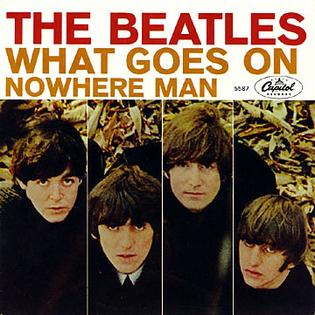
" What Goes On " is a song by the English rock band the Beatles, featured as the eighth track on their 1965 album Rubber Soul . The song was later released as the B-side of the US single "Nowhere Man", and then as the tenth track on the North America-only album Yesterday and Today . It is the only song by the band credited to Lennon–McCartney–Starkey and the only song on Rubber Soul that features Ringo Starr on lead vocals. The song reached number 81 on the US Billboard Hot 100 in 1966.

" Think for Yourself " is a song by the English rock band the Beatles from their 1965 album Rubber Soul . It was written by George Harrison, the band's lead guitarist, and, together with "If I Needed Someone", marked the start of his emergence as a songwriter beside John Lennon and Paul McCartney. The song's lyrics advocate independent thinking and reflect the Beatles' move towards more sophisticated concepts in their writing at this stage of their career. The song has invited interpretation as both a political statement and a love song, as Harrison dismisses a lover or friend in a tone that some commentators liken to Bob Dylan's 1965 single "Positively 4th Street". Among musicologists, the composition has been recognised as adventurous in the degree of tonal ambiguity it employs across parallel major and minor keys and through its suggestion of multiple musical modes.
" Drive My Car " is a song by the English rock band the Beatles, written primarily by Paul McCartney, with lyrical contributions from John Lennon. It was first released on the band's 1965 album Rubber Soul as the opening track. The song later appeared in North America on the Yesterday and Today collection, again to open the record, as the track had been dropped from the American version of Rubber Soul .
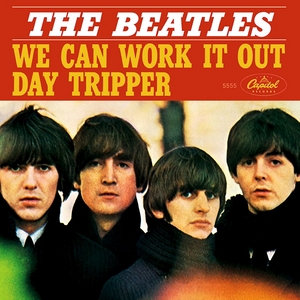
" Day Tripper " is a song by the English rock band the Beatles that was released as a double A-side single with "We Can Work It Out" in December 1965. The song was written primarily by John Lennon with some contributions from Paul McCartney and was credited to the Lennon–McCartney partnership. Both songs were recorded during the sessions for the band's Rubber Soul album. The single topped charts in Britain, Ireland, the Netherlands and Norway. In the United States, "Day Tripper" peaked at number five on the Billboard Hot 100 chart and "We Can Work It Out" held the top position.
" If I Needed Someone " is a song by the English rock band the Beatles, written by George Harrison, the group's lead guitarist. It was released in December 1965 on their album Rubber Soul , except in North America, where it appeared on the June 1966 release Yesterday and Today . The song reflects the reciprocal influences shared between the Beatles and American band the Byrds. On release, it was widely considered to be Harrison's best song to date. A recording by the Hollies was issued in Britain on the same day as Rubber Soul and peaked at number 20 on the national singles chart.

" The Night Before " is a song by the English rock band the Beatles from their 1965 film Help! and soundtrack album of the same name. It was written primarily by Paul McCartney and credited to the Lennon–McCartney partnership. Described as a pop rock or rock and roll song, its lyrics reflect on the singer's last night with his lover before being abandoned.
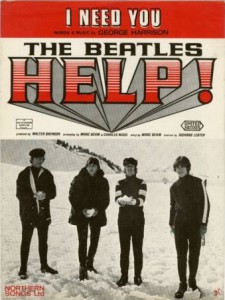
" I Need You " is a song by the English rock band the Beatles from their 1965 album Help! It was written by George Harrison, the group's lead guitarist, and was the second composition of his to be released by the Beatles. The track appears in their film Help! , in a scene filmed on Salisbury Plain where the group were under military protection from a murderous cult.

" Another Girl " is a song by the English rock band the Beatles from their 1965 album Help! and included in the film of the same title. The song was written by Paul McCartney and credited to the Lennon–McCartney partnership. The song is addressed to the singer's girlfriend, who is informed that the singer has found "another girl."

" Tell Me What You See " is a song by the English rock band the Beatles that first appeared in 1965 on their album Help! in the United Kingdom and on Beatles VI in the United States. The song is credited to Lennon–McCartney but mainly written by Paul McCartney. Regarding the song's authorship, McCartney said, "I seem to remember it as mine. I would claim it as a 60–40 but it might have been totally me." John Lennon said, in his interviews with Playboy (1980) and Hit Parader (1972), that "Tell Me What You See" was written completely by McCartney.
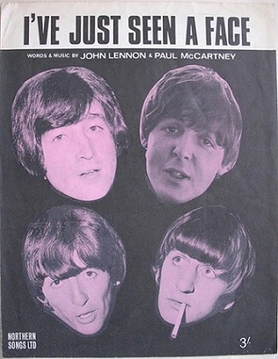
" I've Just Seen a Face " is a song by the English rock band the Beatles. It was released in August 1965 on their album Help! , except in North America, where it appeared as the opening track on the December 1965 release Rubber Soul . Written and sung by Paul McCartney, the song is credited to the Lennon–McCartney partnership. The song is a cheerful love ballad, its lyrics discussing a love at first sight while conveying an adrenaline rush the singer experiences that makes him both enthusiastic and inarticulate.
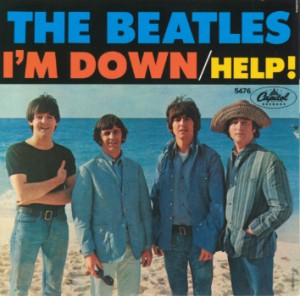
" I'm Down " is a song by the English rock band the Beatles, written by Paul McCartney and credited to Lennon–McCartney. It was released on a non-album single as the B-side to "Help!" in July 1965. The song originated in McCartney's attempt to write a song in the style of Little Richard, whose song "Long Tall Sally" the band regularly covered.
" She's a Woman " is a song by the English rock band the Beatles, written primarily by Paul McCartney and credited to Lennon–McCartney. It was released on a non-album single in November 1964 as the B-side to "I Feel Fine", except in North America, where it also appeared on the album Beatles '65 , released in December 1964. Though it was the B-side, it charted in the US, reaching number four on the Billboard Hot 100 and number eight on the Cash Box Top 100 . The song originated in McCartney's attempt to write a song in the style of Little Richard. The lyrics include the first reference to drugs in a Beatles song, with the line "turn(s) me on" referring to marijuana.
The Beatles staged their second concert tour of the United States in the late summer of 1965. At the peak of American Beatlemania, they played a mixture of outdoor stadiums and indoor arenas, with historic concerts at Shea Stadium in New York and the Hollywood Bowl. Typically of the era, the tour was a "package" presentation, with several artists on the bill. The Beatles played for just 30 minutes at each show, following sets by support acts such as Brenda Holloway and the King Curtis Band, Cannibal & the Headhunters, and Sounds Incorporated.

The Beatles staged their third and final concert tour of North America in August 1966. It consisted of 18 performances, with 16 shows in United States venues and two in Canada. The tour was plagued with backlash regarding the controversy of John Lennon's remark about the Beatles being "more popular than Jesus", death threats, and the band's own dissatisfaction with the noise levels and their ability to perform live. Their speaking out against the Vietnam War added further controversy to the visit.
- ↑ MacDonald 1998 , p. 380.
- ↑ Miles 2001 , pp. 216, 219–20.
- ↑ Miles 2001 , pp. 215–16.
- 1 2 3 4 5 6 7 Everett 2001 , p. 335.
- ↑ Unterberger 2006 , p. 141.
- ↑ Womack 2014 , pp. 116–17.
- ↑ Schaffner 1978 , p. 43.
- ↑ Rodriguez 2012 , p. 4.
- ↑ Easlea, Daryl (2007). "The Beatles Rubber Soul Review" . BBC Music . Retrieved 2 April 2016 .
- ↑ Schaffner 1978 , pp. 45, 51.
- 1 2 3 Smith, Alan (10 December 1965). "Beatles Terrific ... and Rest of Bill". NME . p. 20. Available at Rock's Backpages (subscription required).
- 1 2 Miles 2001 , p. 215.
- ↑ Winn 2008 , p. 292.
- ↑ Womack 2014 , pp. 52, 265.
- 1 2 3 Miles 2001 , p. 216.
- 1 2 3 4 5 Smith, Alan (17 December 1965). "London Turns on the Beatlemania". NME . p. 10. Available at Rock's Backpages (subscription required).
- ↑ Everett 2001 , pp. 335, 348.
- 1 2 Miles 2001 , p. 219.
- ↑ Miles 2001 , pp. 219–20.
- 1 2 Miles 2001 , p. 220.
- ↑ Castleman & Podrazik 1976 , p. 337.
- 1 2 Womack 2014 , p. 792.
- ↑ Staff writer (1 September 2009). "The Beatles live in Cardiff, 1965" . BBC Wales . Retrieved 22 January 2017 .
- ↑ Rodriguez 2012 , pp. 3–4.
- ↑ Miles 2001 , pp. 216–20.
- Castleman, Harry; Podrazik, Walter J. (1976). All Together Now: The First Complete Beatles Discography 1961–1975 . New York, NY: Ballantine Books. ISBN 0-345-25680-8 .
- Everett, Walter (2001). The Beatles as Musicians: The Quarry Men through Rubber Soul . New York, NY: Oxford University Press. ISBN 0-19-514105-9 .
- MacDonald, Ian (1998). Revolution in the Head: The Beatles' Records and the Sixties . London: Pimlico. ISBN 978-0-7126-6697-8 .
- Miles, Barry (2001). The Beatles Diary Volume 1: The Beatles Years . London: Omnibus Press. ISBN 0-7119-8308-9 .
- Rodriguez, Robert (2012). Revolver: How the Beatles Reimagined Rock 'n' Roll . Milwaukee, WI: Backbeat Books. ISBN 978-1-61713-009-0 .
- Schaffner, Nicholas (1978). The Beatles Forever . New York, NY: McGraw-Hill. ISBN 0-07-055087-5 .
- Unterberger, Richie (2006). The Unreleased Beatles: Music & Film . San Francisco, CA: Backbeat Books. ISBN 978-0-87930-892-6 .
- Winn, John C. (2008). Way Beyond Compare: The Beatles' Recorded Legacy, Volume One, 1962–1965 . New York, NY: Three Rivers Press. ISBN 978-0-3074-5239-9 .
- Womack, Kenneth (2014). The Beatles Encyclopedia: Everything Fab Four . Santa Barbara, CA: ABC-CLIO. ISBN 978-0-313-39171-2 .
- .mw-parser-output .navbar{display:inline;font-size:88%;font-weight:normal}.mw-parser-output .navbar-collapse{float:left;text-align:left}.mw-parser-output .navbar-boxtext{word-spacing:0}.mw-parser-output .navbar ul{display:inline-block;white-space:nowrap;line-height:inherit}.mw-parser-output .navbar-brackets::before{margin-right:-0.125em;content:"[ "}.mw-parser-output .navbar-brackets::after{margin-left:-0.125em;content:" ]"}.mw-parser-output .navbar li{word-spacing:-0.125em}.mw-parser-output .navbar a>span,.mw-parser-output .navbar a>abbr{text-decoration:inherit}.mw-parser-output .navbar-mini abbr{font-variant:small-caps;border-bottom:none;text-decoration:none;cursor:inherit}.mw-parser-output .navbar-ct-full{font-size:114%;margin:0 7em}.mw-parser-output .navbar-ct-mini{font-size:114%;margin:0 4em} v
- " Day Tripper "
- " We Can Work It Out "
- " 12-Bar Original "
- The Beatles discography
- Yesterday and Today
- Nowhere Man (EP)
- This Bird Has Flown – A 40th Anniversary Tribute to the Beatles' Rubber Soul
- The Beatles albums :
- Please Please Me
- With the Beatles
- A Hard Day's Night
- Beatles for Sale
- Rubber Soul
- Sgt. Pepper's Lonely Hearts Club Band
- Magical Mystery Tour
- The Beatles (White Album)
- Yellow Submarine

- Beatles Concerts / Beatles Liverpool / Beatles photos / Beatles Tours
The final UK Tour December 1965
by admin · Published March 4, 2012 · Updated March 28, 2022

The Beatles on tour: Glasgow premiere
When I first started this blog, I was deep into my research of three early Beatles tours, The Helen Shapiro Tour , The Roy Orbison Tour and The Montez/Roe Tour . The reason for my research was that I had committed myself to write articles on those tours for the Norwegian Beatles fanzine, “Norwegian Wood”. Since then, the fanzine has covered more tours, written by others.
The tour lasted 10 days, and saw The Beatles perform in nine venues across eight cities. Throughout they played a set comprising 11 songs: I Feel Fine, She’s A Woman, If I Needed Someone, Act Naturally, Nowhere Man, Baby’s In Black, Help!, We Can Work It Out, Yesterday, Day Tripper and I’m Down. Paul McCartney performed “Yesterday” solo on an electric organ, and it was also used by John on “We Can Work It Out” and “I’m Down”.
3 December 1965 – Glasgow – Scotland – Odeon 4 December 1965 – Newcastle – England – Newcastle City Hall 5 December 1965 – Liverpool – Liverpool Empire Theatre 7 December 1965 – Manchester – Manchester Apollo 8 December 1965 – Sheffield – Sheffield City Hall 9 December 1965 – Birmingham – Odeon 10 December 1965 – London – Hammersmith Odeon 11 December 1965 – Finsbury Park – Astoria 12 December 1965 – Cardiff – Wales – Capitol Centre
In November, the Beatles rehearsed for the tour at the Donmar rehearsal theatre in London, and were photographed there November 20th by Robert Whitaker, who was the group’s hired photographer at the time (1964-66). This was the second time they made use of this rehearsal stage in Central London, they had previously rehearsed here on October 12th 1963 for their appearance on “Sunday Night at the London Palladium”.

Rehearsals at the Donmar theatre. Photo: Robert Whitaker.

You can find more photos from the rehearsals this day over at Getty images .
On December 1st, The Beatles gathered together in the flat of Mal Evans to rehearse and put together a set list.

Mal’s flat

The tour programme’s front page was a drawing from the new US TV cartoon series, very exotic to UK fans.

A signed copy of the programme
The 16 pages 27cm x 18cm programme had a 4 page Beatles biography, an article by Beatles Monthly Book editor Johnny Dean, some ads and profiles of the other artists and bands who were part of this package tour. Here’s a couple more samples from the programme:

Compere for this tour was up-and-coming showbiz personality Jerry Stevens . The other acts were:
The Moody Blues (with future Wings member Denny Laine , a NEMS act)
The Paramounts (Another NEMS act who later regrouped as Procol Harum)
The Marionettes (coloured pop-soul vocal group)
The Koobas (from Liverpool, aka The Kubas)
Beryl Marsden (18 year old singer from Liverpool with a big voice, no relation)
Steve Aldo (coloured singer, also from Liverpool)
The Beatles knew the Liverpool people from the old days, Beryl used to sing with The Undertakers from when she was just fourteen, and had to stay behind in Liverpool when the group left for Hamburg, because she was under age. She was the girl who The Beatles wanted to offer their composition “Love of The Loved” to, but Brian Epstein decided to give it to his new protege, Cilla Black . Marsden, in return, refused to be managed by Eppy.

Beryl Marsden

The Paramounts
On December 2nd, the Beatles started the drive up to Scotland, when disaster struck. Mal Evans was driving the van with the equipment, and The Beatles followed behind in their famous Austin Princess, with Alf at the wheel. They were carrying two guitars, which were strapped to the back of the car.
As they travelled up the M1 motorway, a passing lorry signalled to The Beatles’ chauffeur Alf Bicknell to pull over.
Here’s Alf: “I went back to this great big articulated vehicle and the driver said to me, ‘I think you’ve dropped a banjo back down the road.’ I couldn’t believe it. So I went back to my car and Neil [Aspinall] and I just stood there looking, we both couldn’t believe it. We just stood there, staring at the back of my car, noticing that the straps were broken. There were two guitars there, but now there was only one. I remember thinking, ‘I can get a lift home,’ I thought that was it. I said to Neil, ‘You’d better tell them.’ He said, ‘No, you tell ’em.’ So I went round to the car and said, ‘I think we’ve lost a guitar.’ In the darkness, a voice comes out, ‘Well if you can find it, you’ll get a bonus.’ This was John. I was always frightened of John more than anyone else, so I said to him, ‘Well, what’s the bonus then?’ He replied, ‘You can have your job back!’ So anyway, we got back in the car and we got to the end of this 12-mile stretch of motorway to turn round to come back. We are coming back on the other side in the fast lane, and I’m going along as slow as I can, and if anyone came, I had to move over to let them pass, and then go back out into the fast lane. But I couldn’t see a thing, nothing. It was raining and it was dark. I told them, ‘I want to go home now.’ We got right to the other end where we started from and we started to come back, but there was nothing. The roads were clear as anything. Then, we started finding little bits of wood, and then a guitar string. We ended up with a little piece of the guitar each. Anyway, there was no more said about it, and I was quite pleased. But I was very sorry it happened, believe me.”

The guitar in question was George Harrison’s Gretsch “Country Gentleman”.
About Alf Bicknell:
Alf was the Beatles’ chauffeur from 1964 to 1966, when the group was at the height of its success.
Dressed in a blue suit, crisp white shirt and tie, he first drove the group in an Austin Princess (registration SST 626) – at that time, he later said, it was one of only two cars in London to have blacked-out windows (the other belonged to Peter Sellers).
Later Bicknell drove the band in John Lennon’s Royce-Royce Phantom V, which was kitted out with a television set. On occasions when any of the Beatles wished to be more discreet, the chauffeur would use a less conspicuous vehicle.
When he started the job, Bicknell wore a peaked cap; but after only a few days Lennon snatched off the cap and threw it out of the window with the words, “You don’t need that, Alf, you’re one of us now.” Bicknell grew his hair below the collar and began sporting dark glasses. “They didn’t treat me as an employee,” he recalled, “but as one of their mates.”
Bicknell was in attendance when the Beatles met Bob Dylan, and when they encountered Elvis Presley in 1965 the chauffeur was pleasantly impressed when Elvis addressed him as “sir”.
The first time he drove the band Bicknell had to collect them from a photo shoot at Emperor’s Gate: “All of a sudden, Whoof! They all dive into the car and we’re off,” he recalled. “Every time I stopped at a traffic light I felt conscious of all the eyes peering in. Between sets of traffic lights, I’m getting faster and faster, and I pull up a bit quick outside this block of flats at one point and Bang! George, who’s sitting on the occasional seat, hits his head on the partition. Let’s just say he was upset. A few choice words were said. I thought, well, that’s it – the shortest job that’s ever happened to Alf.”
But there were no repercussions.
Despite the fact that the group’s car was constantly mobbed by fans, there was only one mishap – at the Finsbury Park Empire, when Bicknell inadvertently ran over a policeman’s foot.
His association with the group came to an end in 1966, when the Beatles decided that they no longer wanted to tour. Thereafter, when in London, they drove themselves – Ringo, according to Bicknell, was “a superb driver”, but “I had to close my eyes with John” .
After leaving the Beatles, Bicknell continued to work as a driver for the rich and famous, until he hurt his hand in a chainsaw accident in his garden, and had to retire. To fund his retirement, Alf began to sell off his memorabilia from the Beatles’ days, and then he wrote his autobiography, “Baby You Can Drive My Car” in 1989, followed by a book and video package called “Alf Bicknell’s Beatles Diary” in 1996. The accompanying DVD was the first Beatles-related DVD to appear, I believe. Alf was also a popular speaker at Beatles conventions until he collapsed and died in his own kitchen in 2004. Still, Alf lives on as a multimedia pioneer of sorts, an app from his diary appeared for the iPhone, the iPad and the iPod Touch in 2011.
GLASGOW: December 3d, the “Rubber Soul” album was released in the UK, along with the group’s new single, “Day Tripper”/”We Can Work It Out”. Two songs from the album and both sides of the single made their live debut tonight in Glasgow, but before the show there was a press conference and a photo session. Ringo was sporting his “Rubber Soul” jacket, as you can also see in the first picture of this blog entry. I’ve posted some of the photos from the Glasgow photo session in previous blog entries, but here they are again, with a few others.

In their dressing room at Odeon The Beatles also took the time to record a message for Radio Scotland, a new pirate station.
This was the fourth time The Beatles played at the Odeon; the first had been during the Roy Orbison tour on 7 June 1963. They also performed at the city’s Concert Hall later in the year.
Due to bad weather Brian Epstein decided that The Beatles should stay in a hotel in the city centre, rather than the smaller one further out they had been booked to stay in. The was some concern that the location of the new hotel could have proved a security risk, but the group came to no harm.
Alf: “Well a change of direction this morning. Instead of going up to a quiet little hotel, just outside Glasgow, the bad weather made Brian change our hotel to one in Glasgow. Security was high, but that’s to be expected I suppose. The boys gave a very good show and the fans went away with their ears ringing and very happy. John had a surprise visitor, it was his cousin Stanley, only noone knew him and we gave him a hard time trying to get in. People just don’t realise how many borthers, sisters, and other long lost relative the boys have. They’re always one at every show”.
There was a visit from one of those pirate radio boys tonight, which really pleased everybody. He made a tape recording with them all to open the new radio when it goes on the air. John, especially, was all for it, being free and all. The new single and long player went on sale today, as the fans are already aware I’m sure. Well it’s snowing outside and we are off to Newcastle tomorrow, so I’d better get to bed and get some rest.”
The Beatles had a tough drive through snow to get to their two concerts at the City Hall in Newcastle. It was the fourth and final occasion they visited the venue. Over to Alf:
“Another good show again tonight. The boys are going out of their way to make sure that this tour is a good one. Everyone is having a grand time despite all the hard work. We had an early start this morning because of the snow, it was falling fast as we woke and continued for the journey down to Newcastle. Tomorrow is very important for the boys because it is back to Liverpool and Brian wants it all to go very well. There are going to be lots of special people there to watch the boys back in their own home town.”
Also, we have an eye witness report from a fan, courtesy of Carolyn Lee Mitchell’s book, “All Our Loving”: Towards the end of the year the Beatles were back in Britian, continuing their exhausting schedule of concerts. On 04 December they appeared at the Newcastle City Hall where prior to the performance 7,000 fans had virtually fought to get tickets. In the bedlam and mayhem one girl nearly lost all her clothes and ended up wrapped in a blanket. One hundren and twenty fans had to be given first aid treatment and seven were hospitalized.
Barbara was at that concert with her friend Linda. The two of them were another of the small but growing group of fans who really wanted to enjoy the music without all of the screaming. But that was easier said than done: When Linda and I got into the City Hall we could literally feel the incredible electricity that was in the air. It was as though we were in the middle of a of a silent thunderstorm. We found our seats in the second row from teh back and tried to settle ourselves down. We were so nervous excited and happy. We felt like we’d had a drink too many. The compere, Jerry Stevens, introduced the supporting acts which included the Moody Blues. They and the other acts were good, but the last band before the Beatles, called the Marionettes Act 1, seemed to go on and on. We thought they’d never end, but that’s because we knew The Beatles were on next and everyone was getting impatient. Comperes can be very aggravating and Jerry Stevens was no exception as he happily teased the audience. Behind him they were setting up the equipment, and Mal Evans was putting up the drum kit. As he turned the bass drum it displayed the words “The Beatles” and Jerry Stevens just couldn’t make himself heard any more because of the noise that went up. I didn’t scream because I’d already decided that I wouldn’t scream at all but I gave a pretty big sigh anyway. I mean, it really was like a dream for me as I’d never seen the Beatles live before and I was sure I’d wake up. Then I saw Mal Evans carry on Paul’s Hofner. I said to Linda”It’s Paul’s guitar,” like Mal had just brought on Paul himself. Then I knew I wasn’t dreaming. You’ve got to realize I was just 14 at the time and seeing Paul’s guitar in itself was just fantastic! So, like I said, Linda and I had decided we wouldn’t scream because we figured only kids scream. Then we saw John’s guitar brought on and some of George’s equipment and we sat there pinching each other like mad and giggling But when the four of them actually came on it was just the greatest feeling I’d ever had. I know it sounds daft now but at that time The Beatles were so much a part of my life – it was like seeing, I don’t know, four long-lost brothers, I suppose. They seemed so distant with all those spotlights and all those hundreds of screaming girls. It made The Beatles even more untouchable and unreachable but oh, were they lovable! Linda was saying to me, “I dare you to scream. Go on, I dare you.” “Never,” I said, and then suddenly I was screaming along with all the others. It was like I had to get rid of all the anxiety that was inside me, building up all the time. I didn’t know how else to express myself. So I screamed.

Tuning up at the Empire, Liverpool
The Beatles’ final two live concerts in Liverpool took place on this evening at the city’s Empire Theatre.
The 2,550-seat venue could have sold out many times over; more than 40,000 applications were made for tickets, leaving many fans disappointed. However, none could have known that it would be The Beatles’ last appearance in the city. It was the sixth occasion that the group had visited the venue.
The group invited many friends and relatives to see their performance. During the second show Paul McCartney joined The Koobas, one of the support acts, onstage to play drums during their version of Dizzy Miss Lizzy.
Alf: “A night to remember! Here’s me joking how many relatives the boys seem to have, and when they get to Liverpool they really do seem to have those many. George’s mum and dad were there, as was Pattie, lovely people. There were lots of old friends of the boys, as well, as John had been busy giving tickets away all over the place. I’ve got a bit of a rest tomorrow, because everyone is staying here so that the boys can go home for a visit. Mind you I do need a rest after that journey down from Newcastle. That was bad!”

“Save the Cavern Club!” fans
Two fans were handing out leaflets all about a “Save the Cavern Club” campaign outside the Empire. Paul had them brought in to explain. It appeared that the club had fallen on hard times. The Merseybeat era was over, and the discoteques had started to flourish. Live music entertainment did not bring in audiences as much as earlier. The city council had also demanded that the club owner Ray McFall should have new plumbing and toilets fitted, and he didn’t have the money to do it. The Beatles lent their support to the club in a press conference before their concert, but offered no money. The club eventually closed, but reopened again under new management, and McCartney paid the club a revisit in 1968. The next day was a day off in Liverpool, visiting friends and family, a slow day for Alf:
“Quite, quiet today, just a bit of running around, dropping the boys off at various places and picking them up. Met some nice people. We’re off to Manchester in the morning, shouldn’t be any bother, everything’s going very well.”
MANCHESTER (Ardwick)
Alf: “Just my luck! Just when all was going well, fog! I had no problem getting out of Liverpool and we had a good trip over to Manchester, but when we got there the whole place was covered in a blanket of really bad fog. We drove through Manchester at a crawl, which is very bad for the boys because of the fans, but no-one could see us because of the fog! It must have taken us a good four hours, ridiculously slow. When we arrived at the Ardwick the boys should have already been on the stage. Still they made it, which is better late than never. It was a bit of a hurry up though. The boys had a visit from Mr. Shenson, the film producer, to talk about their next film. Don’t know what kind of thing it’s giong to be but they all seemed quite excited. Ritchie really seems to enjoy the filming.”
The Beatles may have experienced fog before, but not like this. Seems they were also interviewed back stage by a female radio reporter.

Ringo is still favouring his “Rubber Soul” jacket.

A piano was standing on it’s side in the wings of the stage, and Paul posed beside it. The Beatles Monthly Book cover this concert by sending their regular photographer Leslie Bryce, which is why we have so many photos from this day.

“A smashing day in Sheffield today. A really good show by the boys and I got a quick look around before the show. There are lots of tales about the North, but I really like seeing how people enjoy their daily lives. They are a nice lot up here The boys played at the Gaumont Cinema here and we finished the night with a really good dinner in the hotel after. It was a bit cramped around the table as there was so many of us, what with the Moody Blues as well. They are a good bunch that lot and they get on well with the boys. Had a few problems at one of the doors with a few fans who wouldn’t take no for an answer. They wanted to see the boys of course, but some of them get a bit too frantic. A good day anyway.”
Some photos from that dinner with the Moodies, Alf is smoking away at the back:

BIRMINGHAM:
Hometown of the Moody Blues. Alf:
“Drove down to Birmingham in torrential rain. The heavens just opened up on us. Still we managed to get there in on piece. Birmingham is a nightmare to get around, it’s so big and expanding all the time. I think it was a Sunday the last time we were here. Didn’t seem much different as I didn’t get a chance to get out anyway. The boys are really giving their all on this tour, both on the stage for the fans and back stage! They are hell bent on having a good time. And why not! The police were good to us again, as in fact they have been for most of the time. It usually costs a few autographs, not always by the boys I might add, but it helps to keep people happy. Brian likes to see that everyone, espeically the boys, is kept happy. I just wish he’s smile a bit more himself. He takes so much on does that man. It’s back down to London tomorrow, where Brian feels better and more at home and in control.”
LONDON HAMMERSMITH:

“Back home with Jean and Mark. So glad to be back! It’s good to be in my own bed agan. I seem to be able to relax better at home. Anyway the boys did the Hammersmith Odeon to a fantastic crowd. I think the Londoners have really taken the boys into their hearts, as if they came from her. All the press were out again to make a big show for the papers. Good for publicity, Brian says. That is as long as John doesn’t tell them what he really thinks.”
Also on this day, the New Musical Express announced the results of its annual Readers Poll. The Beatles were voted Best British Group and Best World Group, while John Lennon was voted British Vocal Personality.
LONDON FINSBURY PARK:
George Harrison: “This is one of the most incredible shows we’ve done. Not just because of the audience, but because they’re Londoners. This is the funny thing. It’s always been the other way round – fantastic in the North but just that little bit cool in London. It’s incredible. It seems like the Beatlemania thing is happening all over again.”
Alf agrees:
“Good old Finsbury Park gave the boys a tremendous reception. I suppose it was because it will be their last show in London this year, until after their American tour next year. We had a good night back stage, celebrating. Again! Tomorrow is in fact the last show, but it’s up in Cardiff and the boys don’t have so many places to visit up there or so many faces around, so they made the best of it here tonight. Best of all was that I was able to come back home again. So it’s up to Wales in the morning, better get some sleep”

Rehearsals at the Donmar theatre
2,500 fans saw each concert.
Between their two sets The Beatles ate sausages and mashed potato in their dressing room backstage, and watched a Western on television.
During the second show a male fan appeared on stage and attempted to grab Paul McCartney and George Harrison. He was quickly bundled away by security staff and thrown out of the venue.
After the concert the group piled into their black limousine to drive back to London to attend a Christmas party at the Scotch Of St James nightclub.
Alf finished his diary entry earlier in the day:
“Not a bad journey up with the boys, following Mal, who left eariler with all the equipment. I dont’ know what is going to happen tonight, only Ritchie wants to come straight back after the show because he wants to go to the big Christmas party at Scotch of St. James’s. Anyway this is it, the last show of the year. After this, when all the equipment and stuff is back, I should have a little time for the family over Christmas. Brian has promised us all a nice bonus. We’ve all nearly had a grand time, hard work, but smashing stuff. Anycase the boys are due to go on soon so I’d better sign off for now.”
Although fairly well documented in accounts from the tour and photos, nothing circulates from the tour in the form of audio or video. In Creasy’s book, two of the concerts are described, one of which even brings details about what The Beatles were saying to the audience between songs. By all accounts, these details must have come from written reports from the day. Unless a journalist recorded a concert in order to transcribe it later. For bootleg collectors, finding a tape of a concert from this tour is almost akin to discovering the whereabouts of the holy grail. We all want to hear how “We Can Work It Out” sounded live, these were the only concerts where it was performed. We want to hear Paul doing “Yesterday” solo, while playing organ, on later tours it was performed arranged for the band. So if you were there and recorded something, by all means, let us know!
10 Responses
- Comments 10
- Pingbacks 0
It's possible that no recording tape has surfaced from this tour? Maybe some private collector have it.
Great post Roger. A lot of work has gone into it and it was really interesting. Thanks.
is there´s any video or audio from this shows on Youtube or anyplace over the internet?
There seems to have appeared an 8mm amateur film from one of the Hammersmith concerts recently. Look at a screen capture posted over at "The Beatles on DVD".
Hi – I have written my story of the tour for "A Ticket to Write" – a German fanzine. I`d like to add that John played "We can work it out" and "I`m down" on organ. I have also researched the audience capacity of the dates:
DAte Venue City 1. Show 2. Show Capacity 3. Dezember 1965 Odeon Cinema Glasgow (Schottland) 18:15 20:45 2.784 4. Dezember 1965 City Hall Newcastle-upon-Tyne 18:30 20:45 3.500 5. Dezember 1965 Empire Theatre Liverpool 17:40 20:00 2.550 7. Dezember 1965 ABC Cinema Manchester 18:30 20:45 2.693 8. Dezember 1965 Gaumont Cinema Sheffield 18:15 20:50 2.300 9. Dezember 1965 Odeon Cinema Birmingham 18:45 21:15 2.439 10. Dezember 1965 Odeon Cinema London, Hammersmith 18:45 21:00 3.487 11. Dezember 1965 Astoria Cinema London, Finsbury Park 18:40 21:10 3.040 12. Dezember 1965 Capitol Cinema Cardiff (Wales) 17:30 20:00 2.800
Thorsten Knublauch
Great post, can you tell me what the hotel was called, that featured at Sheffield, please?
I was at the finsbury park Astoria Christmas Show on 11th December 1965 which was to become their last london show if you dont count the rooftop one in Saville Row.
My Abiding memory of the concert is that the second half of the show which was to feature The Beatles was about to start the lights dimmed and the compere came out onto the apron of the stage in front of the closed velvet curtains and began to build up the already electric atmosphere by standing in the various positions holding an air guitar to enormous screams from the fans of each Beatle eventually he announced ladies and gentleman The Beatles and the beginings of Day Tripper the Number 1 record of the day was heard from behind the still closed curtains the screams were deafening but as the curtains opened it revealed the Moody Blues they laughed and handed the guitars to the laughing Beatles who entered the stage from the wings and then we were off great gag and a great show
Very informative piece. Well done!
Great piece on a lesser known tour. My issue is the setlist opener. On John's Rickenbacker 325 he still has the setlist from this tour taped to it. The first song is missing some of the title, but there are three obvious letters: ZZY. As in Dizzy Miss Lizzy which would have been a great opener. For some reason people have it as I Feel Fine. Is there any review of any of these shows that indicates what the opener was? Based on his guitar (and the fact that Beatles shows were usually 12 songs – without Dizzy they are at 11) I am inclined to think Dizzy Miss Lizzy was the opener. Any proof besides the guitar?
8 December 1965 the concert was at the GAUMONT THEATRE not the Sheffield City Hall !Please adjust your list.
Soon available my book BEATLES LOCATIONS IN LIVERPOOL with 1000+ locations in Liverpool and surroundings (100 miles limit). It will also hold 3000+ pictures.
Leave a Reply Cancel reply
- Next story Ken Scott book coming
- Previous story When was the “Love Me Do” master tape lost?
About The Daily Beatle
This website is all about The Beatles and the individual members of The Beatles – news and articles. The text is © Roger Stormo, unless otherwise noted. We have no responsibility for links that go outside this blog.
Subscribe to new posts via Email
Enter your email address to subscribe to our site and receive notifications of new posts by email.
Email Address

Special Pages
- Abbey Road – The road that goes on forever
- The Beatles after The Beatles – solo gigs
- Paul McCartney – Music video collection 1970-2021 part 1
- Paul McCartney Music Videos 1970-2021 Part 2
- Ringo Starr: Music videos
- George Harrison: music videos
- The Beatles: Music Videos
- John Lennon: Music videos
- Living the Beatles Legend
Recent Comments
- Patrick Wouters - Senang producties on Band On The Run book
- Dennis Carmichael on Beryl Williams
- Ian Beaumont on Let It Be – at last
- admin on Let It Be – at last
- binance kód on Paul Live at the Cavern Club 2018 coming up
- Tim W on Let It Be – at last
- wizz on 1974 Wings album coming?
- Blakey on Let It Be – at last
- angellus8e9025cca8 on Let It Be – at last

THE BEATLES 1965 UK Tour Program
SETLIST - Hammersmith Odeon, London, England, 12/10/1965: I Feel Fine, She's a Woman, If I Needed Someone, Act Naturally, (Johnny Russell cover), Nowhere Man, Baby's in Black, Help!, We Can Work It Out, Yesterday, Day Tripper, I'm Down
The Beatles 1965 UK Tour program: Also touring with the MOODY BLUES, who closed the first set (the Beatles closed the second set). Check out the 4-panel poster with George giving some big-teeth attitude!


The Beatles' 1965 UK tour
- Edit source
- View history
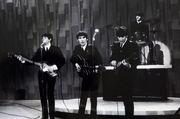
The Beatles' 1965 tour of the United Kingdom was a concert tour that took place between 3 and 12 December 1965, comprising 18 shows at nine venues across England, Scotland and Wales. It coincided with the release of the Beatles' studio album Rubber Soul and their double A-side single "Day Tripper" / "We Can Work It Out", and was the final UK tour undertaken by the band. Weary of Beatlemania, the group conceded to do the tour but refused to also perform a season of Christmas concerts as they had done over the 1963–64 and 1964–65 Christmas seasons.
Background and repertoire [ ]
Whereas the venues for the Beatles' summer 1965 tour of the United States had been arenas and large auditoriums, their UK concerts were all held in theatres and cinemas. The Beatles rehearsed thoroughly for the tour; according to George Harrison's comments to the NME , their ensemble playing was also helped by their having just finished an intensive period of recording for Rubber Soul . The album marked a significant progression from the band's Merseybeat roots, furthering the musical direction they had first adopted with their late 1964 release, Beatles for Sale . For the first time in their setlist for a tour, they now eschewed any songs from before the Beatles for Sale era. The band chose their 1964 hit "I Feel Fine", sung by John Lennon, to open the shows, while their closing song, Paul McCartney's "I'm Down", became what NME journalist Alan Smith later described as "the 1965 'Twist And Shout'".
Typically for the 1960s, the UK concerts were arranged in a package-tour format, with multiple acts on the bill and two performances held each day. The support acts on the program were the Moody Blues, the Paramounts, Beryl Marsden, Steve Aldo, the Koobas, and the Marionettes. At £1000 per engagement, the Beatles' fee was the highest paid to a performing act in Britain up to that time.
The group's preparation ended with a rehearsal on 1 December at the London flat shared by Neil Aspinall and Mal Evans – the Beatles' long-serving road managers and roadies. Aside from the four band members and their manager, Brian Epstein, the tour personnel comprised only Aspinall, Evans, press officer Tony Barrow and a chauffeur, Alf Bicknell. On the way to Scotland for the first show, Harrison's Gretsch Country Gentleman fell from the group's car and into the path of a truck, destroying the instrument and leaving him with two guitars for the tour.
Tour history [ ]
Wild, ear-tingling screams burst over the auditorium as the curtains parted and the Beatles moved straight into their first number, "I Feel Fine". John sang lead, and he was in top vocal – and humorous – form. From time to time he would throw in a funny facial expression that had the crowd roaring with delight.
The opening shows took place at the Odeon Cinema in Glasgow on 2 December. In his feature article covering the first four stops on the itinerary – Glasgow, Newcastle, Liverpool and Manchester – Smith reported that while the fans' reaction did not seem as wild as it had been in previous years, "it's been capacity audiences, screaming [fans] and better-than-ever performances by the group all the way." Part of the reason for the less-frenzied mood surrounding the tour, Smith said, was due to a heavy police presence, which meant that roads around the venues were closed off and crowd numbers were confined to only those attending the concerts.
The Beatles returned to their hometown of Liverpool on 5 December to play at the Empire Theatre, with their friends and family members among the audience. At the second show that evening, McCartney accompanied the Koobas (on drums) during their performance of "Dizzy Miss Lizzy". Otherwise, McCartney expressed disappointment at the level of police protection, saying: "just lately it's getting ridiculous. There are so many of them about, it ruins the whole atmosphere of enjoyment."
The winter weather hindered the band's progress throughout the tour. In Glasgow, Epstein was forced to change their accommodation to an inner-city hotel, to ensure that the Beatles made it on stage. Travel was affected by snow on the roads around Newcastle, by dense fog in Manchester, and by heavy rain on the way to Birmingham. At the first performance at that city's Odeon Cinema, the Moody Blues extended their set to cover for the Beatles' late arrival.
The Beatles played the first of two London venues, the Hammersmith Odeon, on 10 December – the day the NME announced that its readers had voted them Best British Group and Best World Group for 1965. In the same poll, Lennon won in the "British Vocal Personality" category. The following day, Melody Maker listed Rubber Soul at number 1 on its national albums chart.
Finsbury Park Astoria holds 3,000 people and I swear that almost every one of them has been standing on a seat … They tell me the hysteria and the fan scenes were even worse at Hammersmith last night. I did not think I would say this again but, without question, BEATLEMANIA IS BACK!
The 11 December concerts, at the Astoria in Finsbury Park, north London, received what author Barry Miles later described as a "tremendous" reception. Retracting his earlier statement about the growing maturity of the group's fans, Smith wrote: "I have not seen hysteria like this at a Beatles show since the word Beatlemania erupted into headlines … George Harrison staggered off the stage soaking in perspiration as he told me: 'This is one of the most incredible shows we've done. Not just because of the audience, but because they're Londoners!'" Lennon elaborated: "We used to think Londoners had that cool we've-seen-it-all-before outlook but we take it all back!"
The tour ended on 12 December with two performances at the Capitol Cinema in Cardiff. Some 25,000 applications were received for the 5000 tickets. These shows proved to be the final UK concerts the Beatles played outside London, where they went on to perform for the last time at the NME Poll-Winners' Concert in May 1966.
Set list [ ]
According to Walter Everett (lead singers appear in parentheses):
- "I Feel Fine" (John Lennon)
- "She's a Woman" (Paul McCartney)
- "If I Needed Someone" (George Harrison)
- "Act Naturally" (Ringo Starr)
- "Nowhere Man" (Lennon, with McCartney and Harrison)
- "Baby's in Black" (Lennon and McCartney)
- "Help!" (Lennon)
- "We Can Work It Out" (McCartney)
- "Yesterday" (McCartney)
- "Day Tripper" (Lennon and McCartney)
- "I'm Down" (McCartney)
- 1 Jim McCartney
- 2 The Long One
- 3 Dot Rhone
Share this website
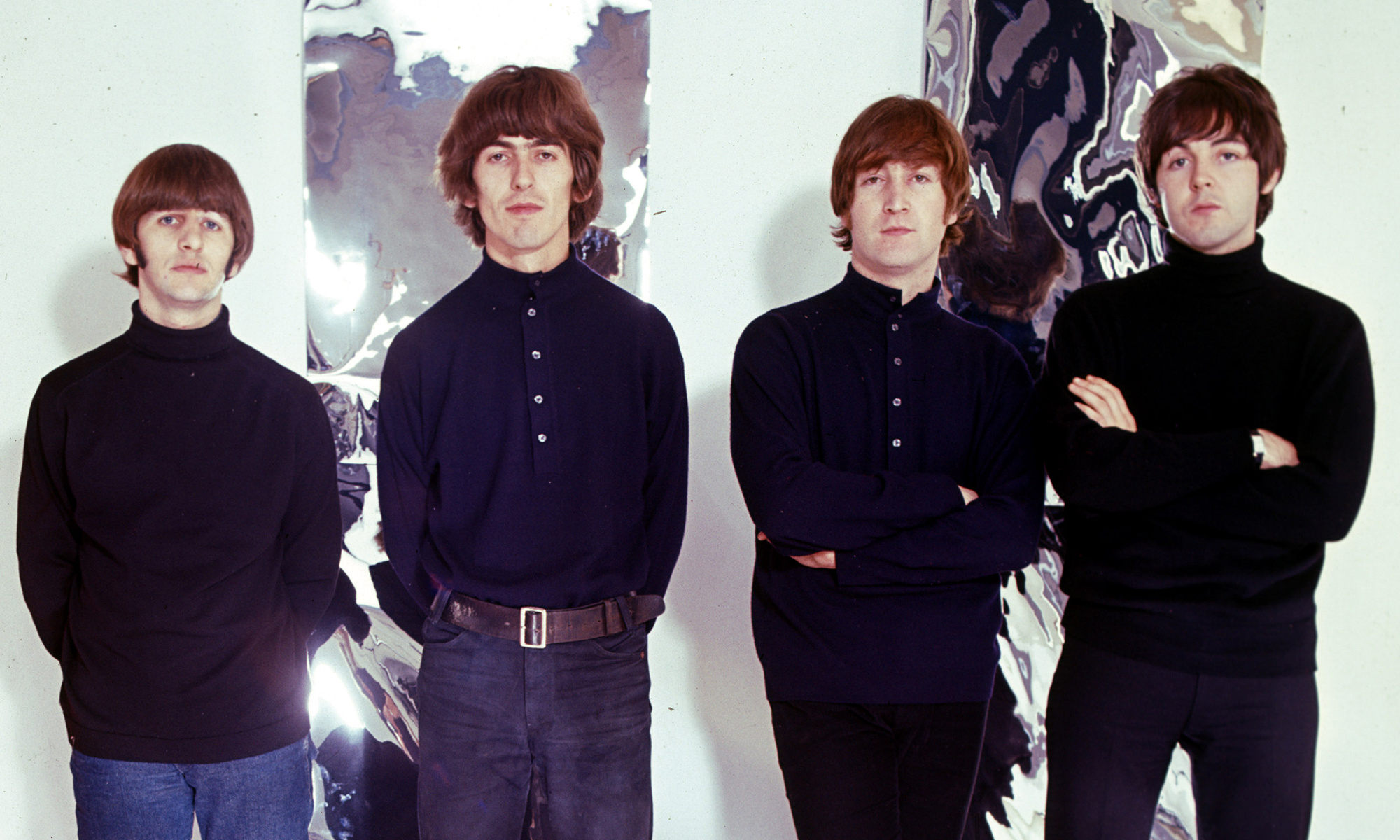
"If you look at our itinerary some of those years where we did maybe a tour of England, a tour of Europe, a tour of America, two albums and about four EPs, and three singles, and made a movie all in the same year - you think, 'Oh Jesus, how did we do that?'"
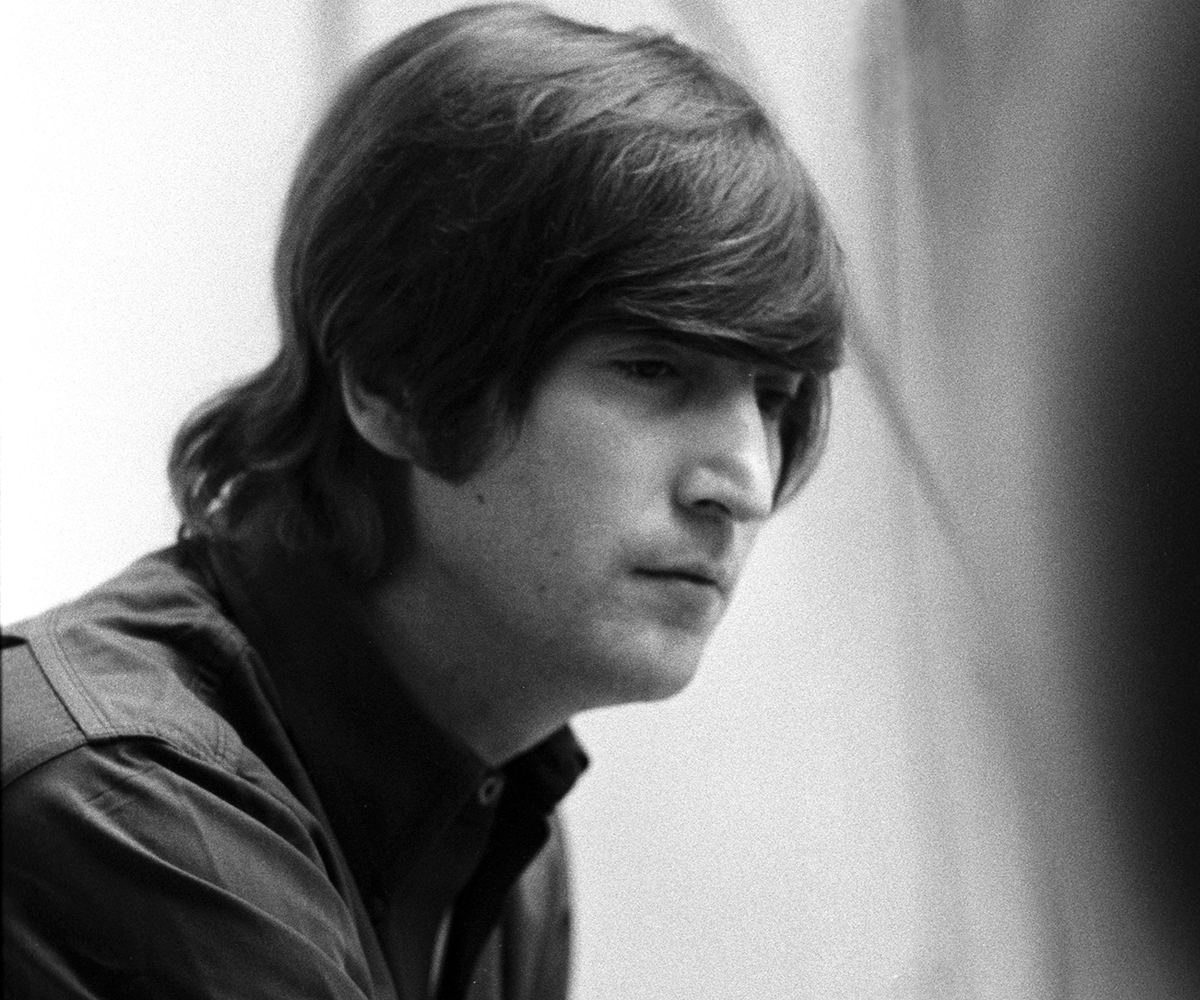
"Rubber Soul, as it was building up it was getting more experimental. The songs were getting better. More interesting... So that's where we were going."
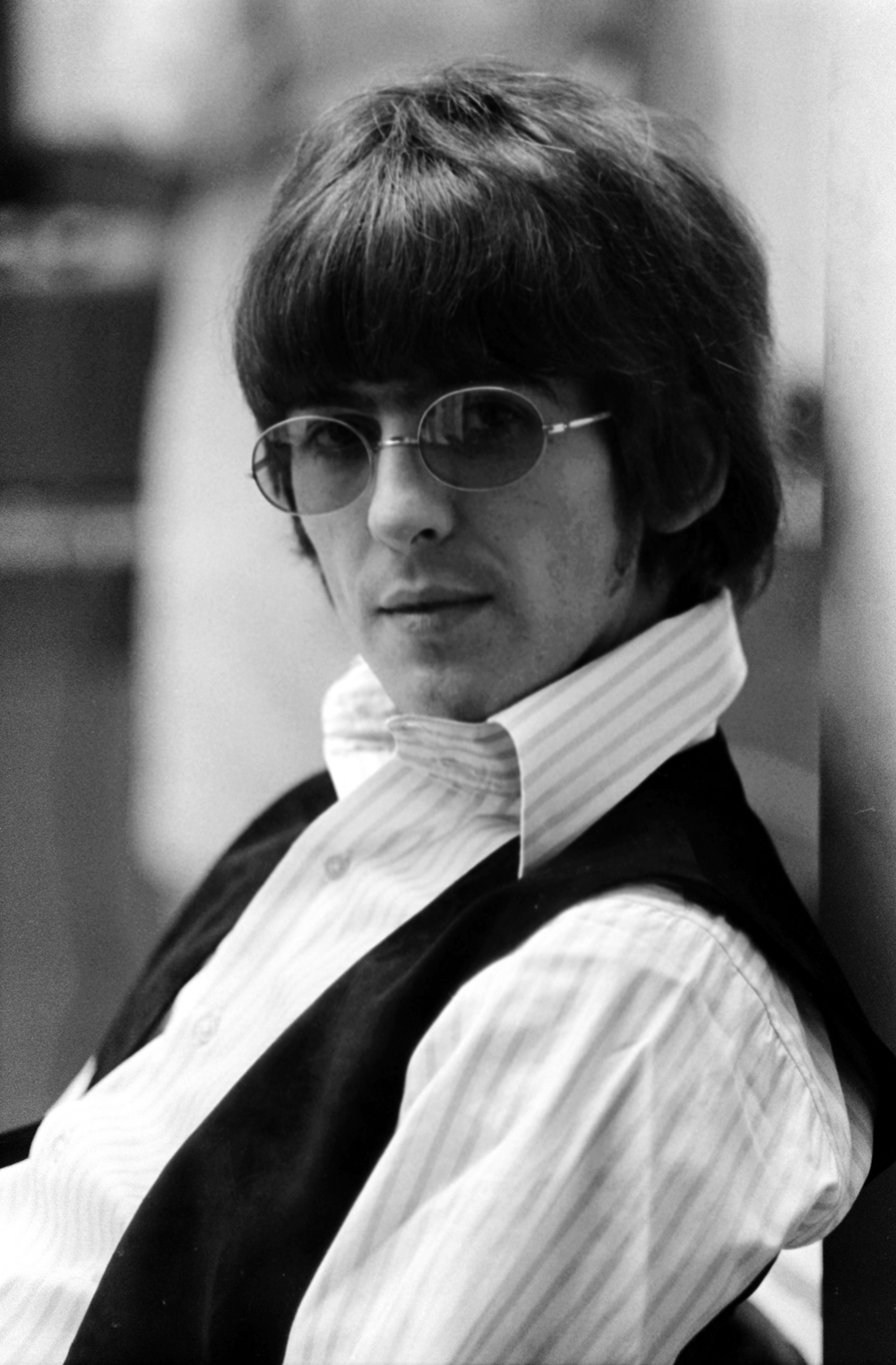
"I really think the Queen believes in it all. She must. I do't believe in John Lennon, Beatle, being any different from anyone else, because I know he's not. I'm just a fella." John
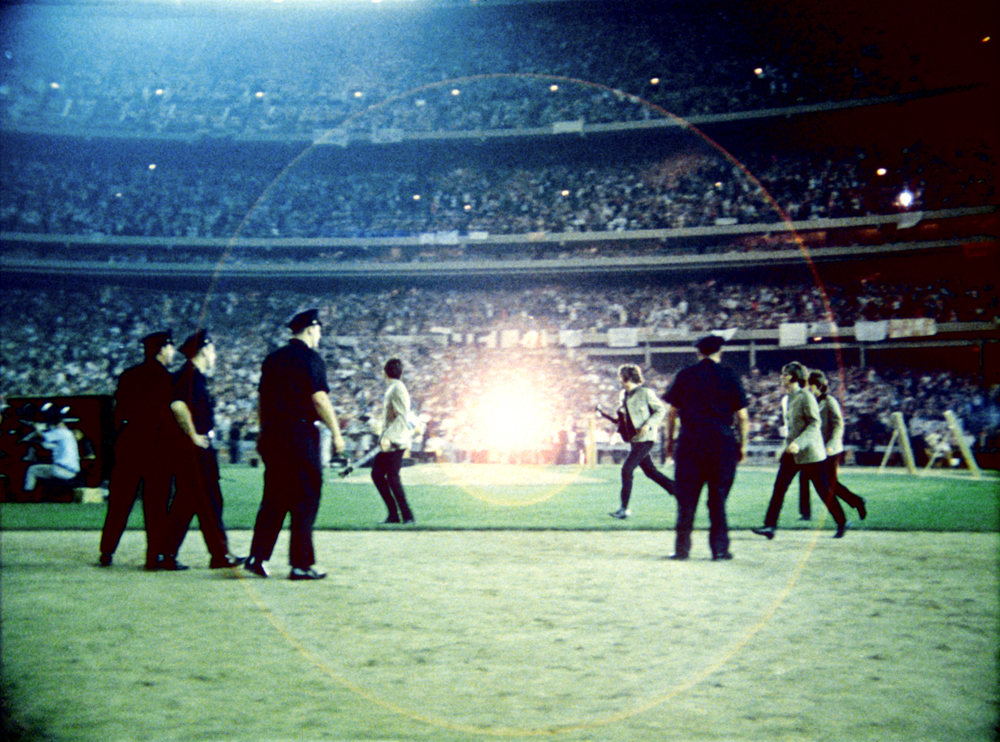
"BEATLES' GREATEST U.S. SHOW TO BE FILMED "British fans may see the Beatles' most important concert ever - on television. The group will appear before nearly 60,000 fans at the Shea Stadium in New York on August 15 at the start of their second American tour." NME Friday, March 12, 1965
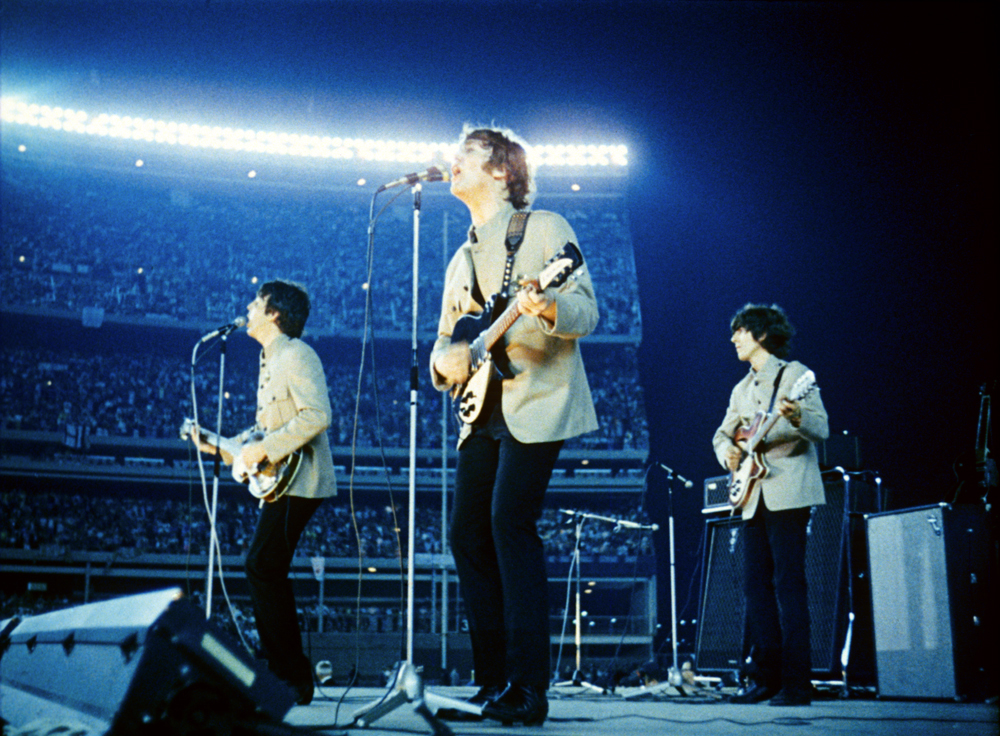
"It was good to make Help! and it's a nice film. It's funny. It's a very period film now. We just took it all very lightly, we'd had a laugh - and in the snow, all the snow scenes were cos the lads wanted a holiday, they were fed up working." - Paul
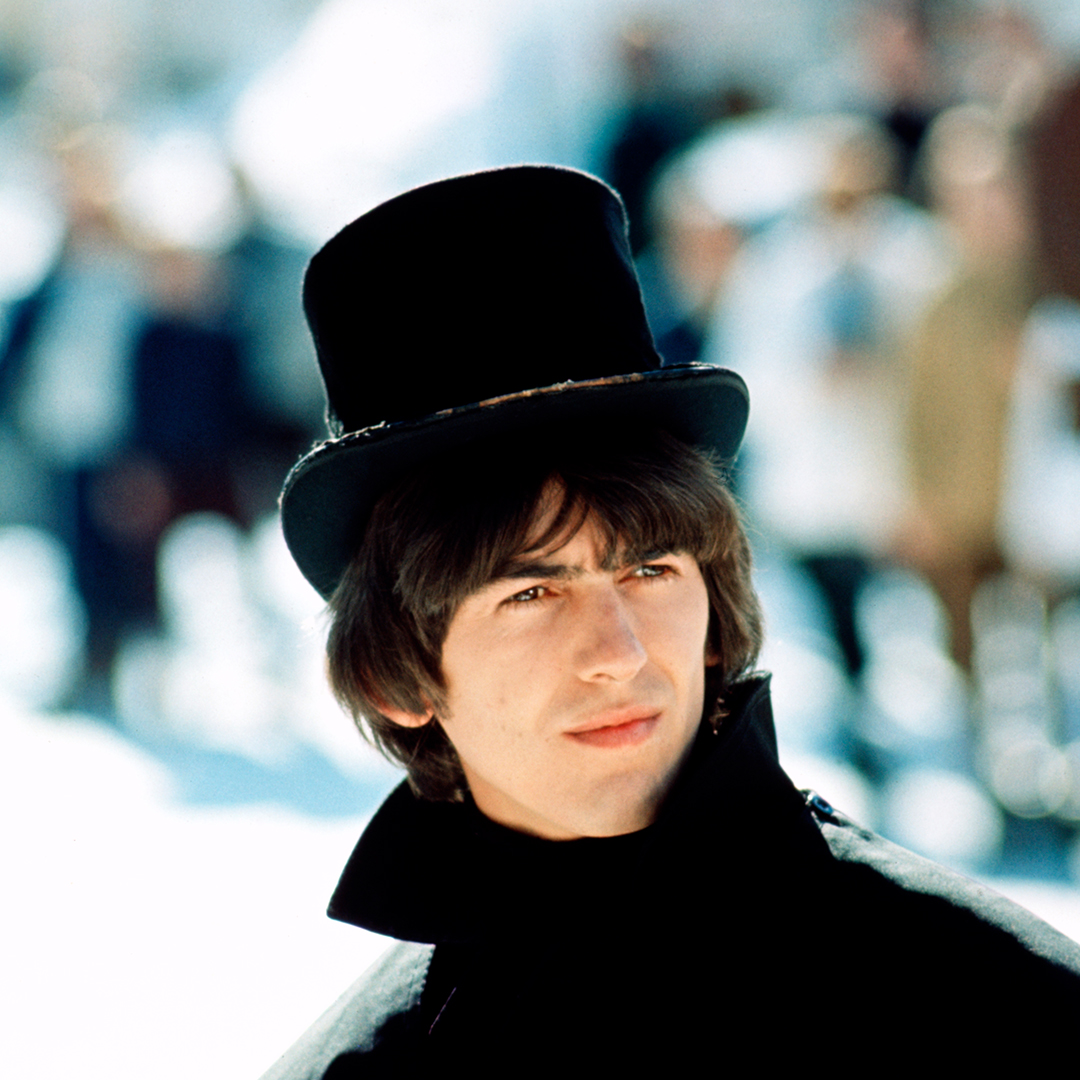
1965 UK Tour

1965 US tour
1966 Germany Tour
Band members
Paul McCartney
Ringo Starr
John Lennon
George Harrison
Spread the love! If you like what you are seeing, share it on social networks and let others know about The Paul McCartney Project.
They had played their last live U.K. concerts three weeks earlier, in early December, although it wasn’t advertised as such. For the concert at the Empire Theater in Liverpool alone, forty thousand fans applied for tickets, against two houses of two thousand five hundred seats each house. Other concerts took them across England, ending at the Capitol Cinema in Cardiff, Wales, on December 12, 1965. As usual, you couldn’t hear the Beatles through the screaming of the fans. As John said afterward in some disgust, “I reckon we could send out four waxwork dummies of ourselves and that would satisfy the crowds. Beatles concerts are nothing to do with music anymore. They’re just bloody tribal rites.” Tony Bramwell – From “ Magical Mystery Tours: My Life with the Beatles “, 2005
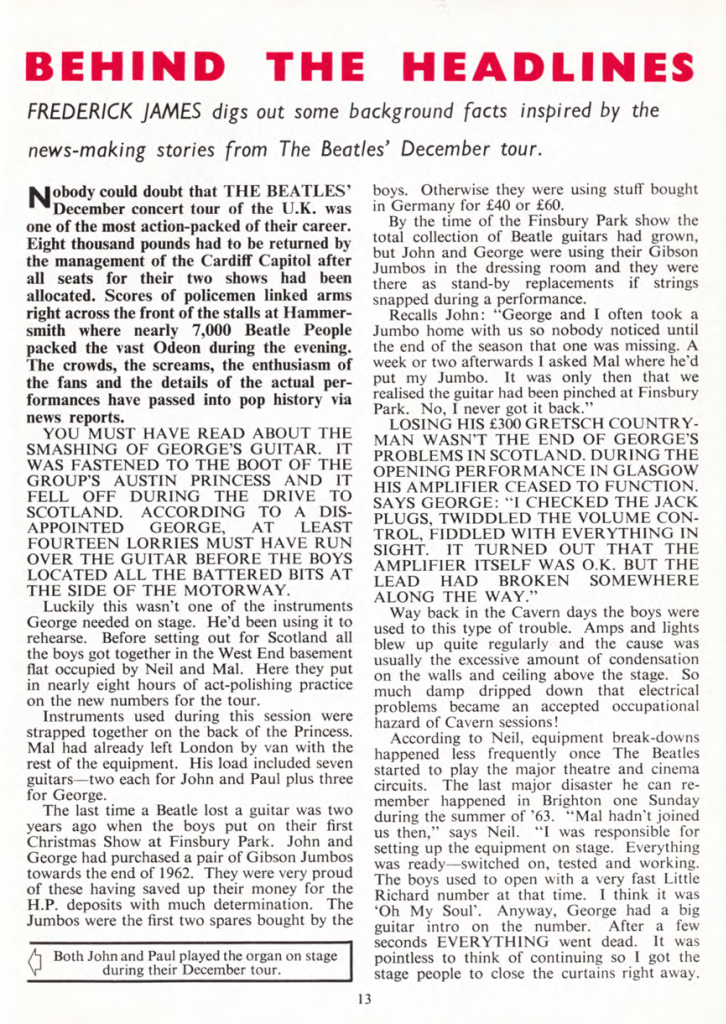
Last updated on December 20, 2023
12 concerts • 1 country
United Kingdom • Cardiff • Capitol Theatre
Dec 12, 1965
United Kingdom • London • Astoria Theatre
Dec 11, 1965
United Kingdom • London • Hammersmith Odeon
Dec 10, 1965
United Kingdom • Birmingham • Odeon Cinema
Dec 09, 1965
United Kingdom • Sheffield • The Gaumont
Dec 08, 1965
United Kingdom • Manchester • Manchester Apollo
Dec 07, 1965
United Kingdom • Liverpool • Empire Theatre • Evening show
Dec 05, 1965
United Kingdom • Liverpool • Empire Theatre • Afternoon show
United Kingdom • Newcastle • Newcastle City Hall • Evening show
Dec 04, 1965
United Kingdom • Newcastle • Newcastle City Hall • Afternoon show
United Kingdom • Glasgow • Odeon Cinema • Afternoon show
Dec 03, 1965
United Kingdom • Glasgow • Odeon Cinema • Evening show
Contribute!
Have you spotted an error on the page? Do you want to suggest new content? Or do you simply want to leave a comment ? Please use the form below!
Cancel reply
Your email address will not be published. Required fields are marked *
The Beatles live: Capitol Cinema, Cardiff
The Beatles’ final UK tour ended with two concerts at the Capitol Cinema in Cardiff, Wales. They had previously performed at the venue on 27 May 1963 and 7 November 1964 .
The support acts were, in order of appearance, The Paramounts, Beryl Marsden with Steve Aldo, The Moody Blues, The Koobas and The Marionettes, and the compere was Jerry Stevens.

2,500 fans saw each concert, which lasted around 30 minutes. The Beatles performed 11 songs: ‘I Feel Fine’ , ‘She’s A Woman’ , ‘If I Needed Someone’ , ‘Act Naturally’ , ‘Nowhere Man’ , ‘Baby’s In Black’ , ‘Help!’ , ‘We Can Work It Out’ , ‘Yesterday’ , ‘Day Tripper’ and ‘I’m Down’ .
Between their two sets The Beatles ate sausages and mashed potato in their dressing room backstage, and watched a Western on television.
During the second show a male fan appeared on stage and attempted to grab Paul McCartney and George Harrison . He was quickly bundled away by security staff and thrown out of the venue.
After the concert the group piled into their black limousine to drive back to London to attend a Christmas party at the Scotch Of St James nightclub.
Also on this day...
- 2018: Paul McCartney live: Echo Arena, Liverpool
- 2017: Paul McCartney live: Qudos Bank Arena, Sydney
- 2012: Paul McCartney live: Madison Square Garden, New York City – 12-12-12: The Concert For Sandy Relief
- 2011: Paul McCartney live: Hartwall Areena, Helsinki
- 1995: US single release: Free As A Bird
- 1993: Paul McCartney live: Estadio River Plate, Buenos Aires
- 1991: George Harrison live: Osaka-jō Hall, Osaka
- 1989: Paul McCartney live: Madison Square Garden, New York City
- 1979: Wings live: Odeon, Birmingham
- 1969: George Harrison live: Falkoner Theatre, Copenhagen with Delaney & Bonnie
- 1969: John Lennon is interviewed for South African radio
- 1969: Album release: Live Peace In Toronto 1969 by Plastic Ono Band
- 1968: John Lennon and Yoko Ono are interviewed for Dutch television
- 1968: John Lennon and Yoko Ono are interviewed for BBC radio’s Night Ride
- 1963: The Beatles live: Odeon Cinema, Nottingham
- 1962: The Beatles live: Cavern Club, Liverpool (evening)
- 1962: The Beatles live: Cavern Club, Liverpool (lunchtime)
Want more? Visit the Beatles history section .
Latest Comments
I still have the ticket stubs for the 5.30 (first) performance. I went with my girlfriend Pat Rees from Trefforest. I was from the Graig Pontypridd. We were 16. If you read this Pat best wishes to you, let me know you’re ok.
Hello there, do you by chance have any photographs of any of the beatles 3 performances at the capitol from 1963 – 65 or know of anyone who does? Also do you have at all a south wales echo souvenir special from the early to mid 60’s of the beatles visit to the capitol?
Do you remember any details as to how We Can Work It Out was performed? Was John playing harmonium? Was he playing a different type of keyboard? Any bit of information would be greatly appreciated. Thank you!
Yes, I was there at the second of the 1965 performances. John was on the right hand side of the stage and played the harmonium, as far as I recollect.
Yes, John sat on the right hand side of the stage (from the audience’s viewpoint) and played the harmonium.
So, you where one of those lucky persons to be there, may I ask you something? Did The Beatles began the show with Dizzy Miss Lizzy, or I Feel Fine? Actually I just saw Lennon’s Ric. 25 and it has a tape in that says the setlist and you can tell it says something like:
ZY(Dizzy Miss Lizzy) FINF(I Feel Fine) WOMAN(She’s A Woman) Etc….
Here’s a link for the pic: https://tilonlysilenceremains.files.wordpress.com/2013/05/setlist.jpg
P.S. Who played the organ in We Can Work It Out? And how was Yesterday played? Only Paul with the organ, or Paul the organ and Lennon playing the Ric. ? Cuase’ I saw a pic of McCartney on the organ and Lennon with his Ric. any info you have, is welcome. Thanks!
So I think I found a treasure for every Beatles fan.. It’s an audio from Yesterday on the Vox Organ from this tour, it’s amazing, I hope we can find an audio from We Can Work It Out or something, that’ll be nice!
As I recall, the first number was I Feel Fine. John sat at the keyboard on the right hand side of the stage (from audience viewpoint) to play keyboard on We Can Work It Out.
Leave a Reply
Looking Back: The Beatles 'invaded' Oregon in 1965. Here is how it looked

The headline read “Portland Overcome by Noise, Hair as the Beatles Invade.”
Reporter Ron Abell and photographer Wayne Eastburn covered the excitement in Portland for The Register-Guard on Aug. 22, 1965.
The Beatles played two shows at Memorial Coliseum to less-than-full houses for each performance, according to the article.
But, “Beatlemania conquered everything Sunday,” Abell wrote.
“Screams, unmeasurable in decibels and unheard in the Northwest at least since the Whitman massacre, filled the Coliseum,” he wrote.
The Fab Four hosted a press conference with media and a handful of young fans who managed to get into the room while enduring questions from the media like, “Are you Communists?”
Answer? “You’re joking. We’re capitalists, boy. We want to keep it coming in.”
Contact photographer Chris Pietsch at [email protected] , or follow him on Twitter @ChrisPietsch and Instagram @chrispietsch
- Search Please fill out this field.
- Manage Your Subscription
- Give a Gift Subscription
- Newsletters
- Sweepstakes
- Entertainment
Guitar Played by John Lennon on Beatles Classics Hits Auction Block After Being Found in an Attic After 50 Years
The instrument is expected to set a new world record for highest-selling Beatles guitar
:max_bytes(150000):strip_icc():format(webp)/Rachel-DeSantis_WebReady_01-73fc4f265b774af2b1bffa35f06385e3.jpg)
Bettmann/Getty
After 50 years, a long-lost guitar played by John Lennon on seminal Beatles hits has been discovered in an attic — and is now up for grabs.
Julien’s Auctions announced Tuesday, April 23 that Lennon’s Framus 12-string Hootenanny acoustic guitar, which he played on classics like “Help!,” “You’ve Got to Hide Your Love Away,” “It’s Only Love,” “I’ve Just Seen a Face” and “Norwegian Wood,” will be up for auction during a two-day event in New York City next month.
A release dubbed the instrument the “most important Beatles guitar to ever come to market,” and noted that it’s expected to go for more than $800,000, and will likely set a new world record for highest-selling Beatles guitar.
“The discovery of John Lennon’s Help! guitar that was believed to be lost is considered the greatest find of a Beatles guitar since Paul McCartney’s lost 1961 Höfner bass guitar ,” Darren Julien, Co-Founder and Executive Director, Julien’s Auctions, said in a statement. “Finding this remarkable instrument is like finding a lost Rembrandt or Picasso, and it still looks and plays like a dream after having been preserved in an attic for more than 50 years. To awaken this sleeping beauty is a sacred honor and is a great moment for Music, Julien’s, Beatles and Auction history.”
The guitar was famously played by Lennon in the movie Help! in the scene where the Beatles perform “You've Got to Hide Your Love Away” and more.
Its location became unknown in the later half of the 1960s after it made its way to Gordon Waller of the British duo Peter and Gordon, and he later gave it to his road managers.
“It was recently discovered in an attic in the rural British countryside where it had lain forgotten and unplayed for over 50 years,” the release said. “The homeowners found the guitar in the midst of their move and contacted Julien’s Auctions.”
While at the house, executives from Julien’s also found the guitar’s original case in the trash and rescued it. The Maton case was made in Australia and can be seen in photos of the Beatles taken in 1965.
David Redfern/Redferns
On Wednesday, April 24, a few photos of Ringo Starr posing with the instrument were shared on social media as he said, "After so many years I’m happy to see this guitar again, thanks to a little ‘Help’ from my friends at Julien’s."
Courtesy Julien's Auctions
The instrument will headline the Music Icons two-day auction event on May 29 and 30 at the Hard Rock Café in New York City and online at juliensaucstions.com. The auction house has previously broken records with Beatles memorabilia sales, including another acoustic guitar of Lennon’s that sold for a record $2.4 million.
Other things up for sale at the event include a Gianni Versace dress worn by Tina Turner on her Wildest Dreams Tour, which is expected to fetch between $4,000 and $6,000, and a handwritten Nirvana set list written by Kurt Cobain , which is expected to get up to $8,000.
The discovery of the late Lennon’s guitar comes months after his bandmate Paul McCartney announced that his 1961 Höfner electric bass guitar had been found and returned to him more than 50 years after it was stolen.
The rocker’s instrument had been taken from a van in London in 1972, and was found with its original case after fans launched The Lost Bass Project in an effort to track it down. The fans discovered that the thief had sold the bass — which can be heard on songs like “Love Me Do” and “She Loves You” — to the owner of the Admiral Blake pub in London.
Related Articles

IMAGES
VIDEO
COMMENTS
The Beatles' 1965 tour of the United Kingdom was a concert tour that took place between 3 and 12 December 1965, comprising 18 shows at nine venues across England, Scotland and Wales. It coincided with the release of the Beatles' studio album Rubber Soul and their double A-side single "Day Tripper" / "We Can Work It Out", and was the final UK tour undertaken by the band.
The Beatles arriving for concerts in Madrid, July 1965. From 1962 to 1966, the English rock band the Beatles performed all over the Western world. They began performing live as The Beatles on 15 August 1960 at The Jacaranda in Liverpool and continued in various clubs during their visit to Hamburg, West Germany, until 1962, with a line-up of John Lennon, Paul McCartney, George Harrison, Stuart ...
The Beatles's 1965 Concert History. The Beatles were an English rock band formed in Liverpool in 1960. With the line-up comprising John Lennon, Paul McCartney, George Harrison and Ringo Starr, they are regarded as one of the most influential bands of all time. The group was integral to the development of 1960s counterculture and popular music's ...
Restored by me and synced by AdamBoundCheck out his channel: https://www.youtube.com/channel/UCmWG4hpNb8vftFusIDueFMThe only footage of the 1965 UK tour, sho...
1965 was a seminal year for the Beatles, taking the band from the Beatlemania period through to the second half of the decade, where the group delivered their most critically acclaimed music. Several key events happened this year, from the last ever UK tour through to the moment Lennon and McCartney began to lose control over their own song rights.
The Beatles 1965 European tour; Tour by the Beatles: Start date: 20 June 1965: End date: 3 July 1965: No. of shows: 15: The Beatles concert chronology; 1964 North American tour; 1965 European tour; 1965 US tour; During 1965, the Beatles toured Europe. Set list. The typical set list for the shows was as follows (with lead singers noted):
The Beatles live: Odeon Cinema, Hammersmith, London. Friday 10 December 1965 Live 22 Comments. The Beatles played four concerts in London over two days during their final UK tour. The first two took place at the Hammersmith Odeon on this day. They performed 11 songs: 'I Feel Fine', 'She's A Woman', 'If I Needed Someone', 'Act ...
beatles recording and release database. beatles recording and release database beatlesdb. album sessions. live shows. find. home; Live Tour; 1965 UK Tour; 1965 UK Tour ... beatlesdb. album sessions. live shows. find. home; Live Tour; 1965 UK Tour; 1965 UK Tour. Jan Feb Mar Apr May Jun Jul Aug Sep Oct Nov Dec 1965 S M T W T F S. Date Id; Dec 3 ...
The Beatles' 1965 tour of the United Kingdom was a concert tour that took place between 3 and 12 December 1965, comprising 18 shows [1] at nine venues across England, Scotland and Wales. [2] It coincided with the release of the Beatles' studio album Rubber Soul and their double A-side single "Day Tripper" / "We Can Work It Out", and was the final UK tour undertaken by the band. [3]
John. "BEATLES' GREATEST U.S. SHOW TO BE FILMED "British fans may see the Beatles' most important concert ever - on television. The group will appear before nearly 60,000 fans at the Shea Stadium in New York on August 15 at the start of their second American tour." NME Friday, March 12, 1965. "If you look at our itinerary some of those years ...
For the new issue of "Norwegian Wood", I was asked to write about the final UK tour, which happened in December 1965, and so I set about researching again. Last year, Martin Creasy published his wonderful book "Beatlemania! The Real Story of The Beatles UK Tours 1963-1965 ". Martin has done a great job in finding old newspaper articles ...
The Beatles undertook six UK tours between 1963 and 1965. For the first they were fourth on a bill headlined by Helen Shapiro; during that first year they also played second fiddle to US singers Chris Montez, Tommy Roe and Roy Orbison, before promoters inevitably acquiesced to fans' demands and made them the main draw.
Concert • By The Beatles • Part of the 1965 UK Tour. See all concerts in United Kingdom on the map Country: United Kingdom City: London Location: Hammersmith Odeon. Timeline. Concert Dec 08, 1965 • United Kingdom • Sheffield. Concert Dec 09, 1965 • United Kingdom • Birmingham.
Beatle 1965 Tour Program with The Moody Blues. SETLIST - Hammersmith Odeon, London, England, 12/10/1965: I Feel Fine, She's a Woman, If I Needed Someone, Act Naturally, (Johnny Russell cover), Nowhere Man, Baby's in Black, Help!, We Can Work It Out, Yesterday, Day Tripper, I'm Down ... The Beatles 1965 UK Tour program: Also touring with the ...
The Beatles' only UK tour of 1965 was also their final one as a group. It began with two shows at the Odeon Cinema in Glasgow. The tour lasted 10 days, and saw The Beatles perform in nine venues across eight cities. Throughout they played a set comprising 11 songs: ...
Nov 30, 2018. The Beatles did their final UK tour in December 1965. December 1965 will forever be remembered as the month The Beatles did their final tour as a group. The tour took place between ...
The Beatles' 1965 tour of the United Kingdom was a concert tour that took place between 3 and 12 December 1965, comprising 18 shows at nine venues across England, Scotland and Wales. It coincided with the release of the Beatles' studio album Rubber Soul and their double A-side single "Day Tripper" / "We Can Work It Out", and was the final UK tour undertaken by the band. Weary of Beatlemania ...
John. "BEATLES' GREATEST U.S. SHOW TO BE FILMED "British fans may see the Beatles' most important concert ever - on television. The group will appear before nearly 60,000 fans at the Shea Stadium in New York on August 15 at the start of their second American tour." NME Friday, March 12, 1965. 1965 Image.
What would turn out to be The Beatles' final UK tour began in December 1965 with two shows in one night at Glasgow's Odeon Cinema. Opening in 1934 and closing in 2006, the Odeon was situated ...
1. 1965 US tour. The Beatles 1962-1970. Spread the love! If you like what you are seeing, share it on social networks and let others know about The Paul McCartney Project. They had played their last live U.K. concerts three weeks earlier, in early December, although it wasn't advertised as such. For the concert at the Empire Theater in ...
The Beatles live: Capitol Cinema, Cardiff. Sunday 12 December 1965 Live 8 Comments. The Beatles' final UK tour ended with two concerts at the Capitol Cinema in Cardiff, Wales. They had previously performed at the venue on 27 May 1963 and 7 November 1964. The support acts were, in order of appearance, The Paramounts, Beryl Marsden with Steve ...
The Framus "Hootenanny" 5/024 12 was a 12-string acoustic guitar made in the company's Bubenruth, Bavaria factory in the early 1960s. In the UK, it could be found in catalogs for a price of 34 Guineas, and it featured a spruce top, mahogany back and sides, a set mahogany neck, a 19-fret rosewood fretboard, and a decorative sound hole ...
The Beatles' 1965 tour of the United Kingdom was a concert tour that took place between 3 and 12 December 1965, comprising 18 shows at nine venues across England, Scotland and Wales. It coincided with the release of the Beatles' studio album Rubber Soul and their double A-side single "Day Tripper" / "We Can Work It Out", and was the final UK tour undertaken by the band.
1965 UK tour. The Beatles staged their second concert tour of the United States (with one date in Canada) in the late summer of 1965. At the peak of American Beatlemania, they played a mixture of outdoor stadiums and indoor arenas, with historic concerts at Shea Stadium in New York and the Hollywood Bowl. Typically of the era, the tour was a ...
Reporter Ron Abell and photographer Wayne Eastburn covered The Beatles concert in Portland for The Register-Guard on Aug. 22, 1965 ... 1965. The Beatles played two shows at Memorial Coliseum to ...
Photo: After 50 years, a long-lost guitar played by John Lennon on seminal Beatles hits has been discovered in an attic — and is now up for grabs. Julien's Auctions announced Tuesday, April 23 ...
The English rock band the Kinks staged their first concert tour of the United States in June and July 1965. The sixteen concerts comprised the third stage of a world tour, following shows in Australasia, Asia and in the United Kingdom and before later stages in continental Europe. Initially one of the most popular British Invasion groups, the Kinks saw major commercial opportunity in the US ...